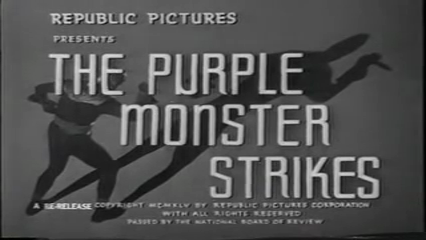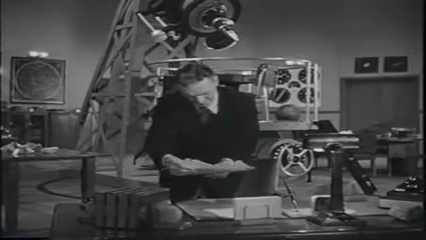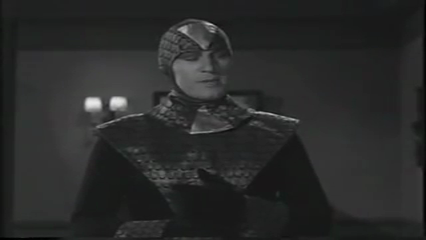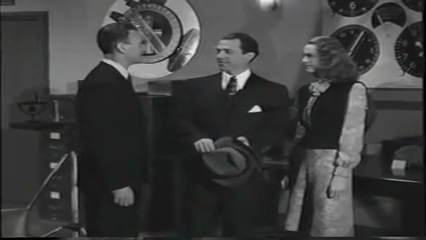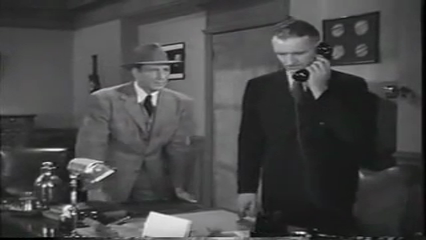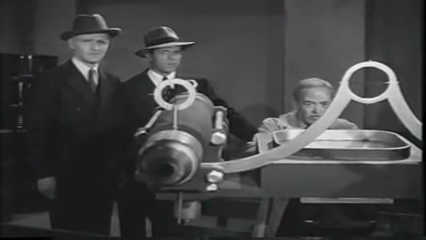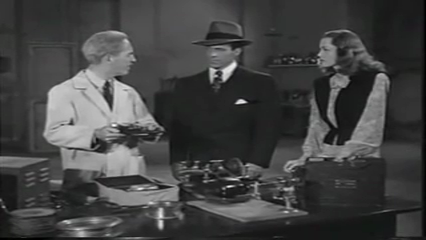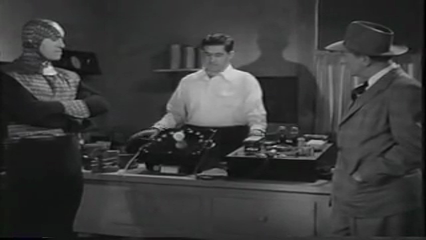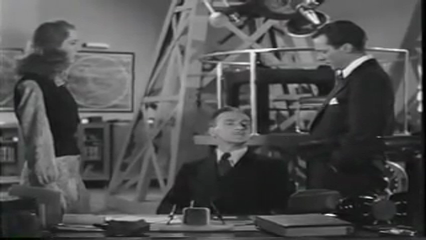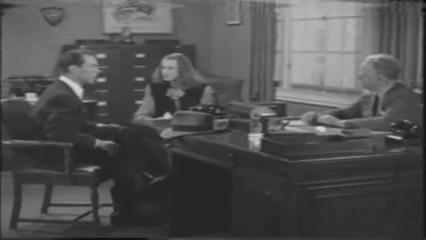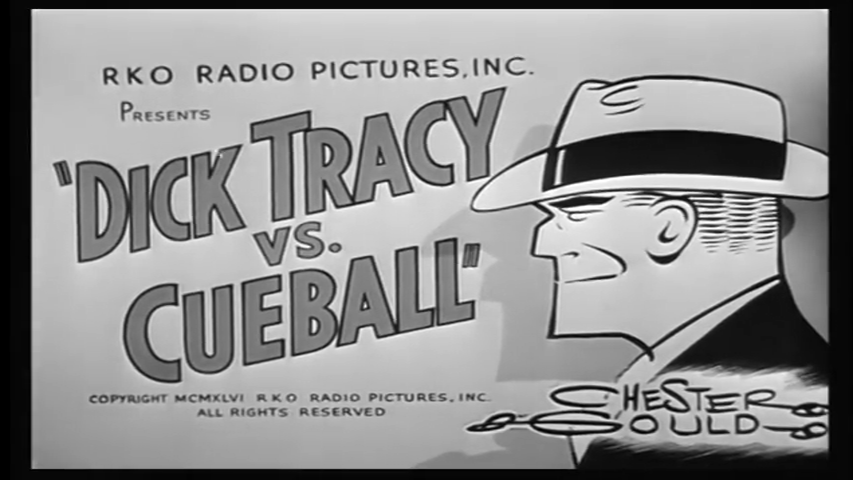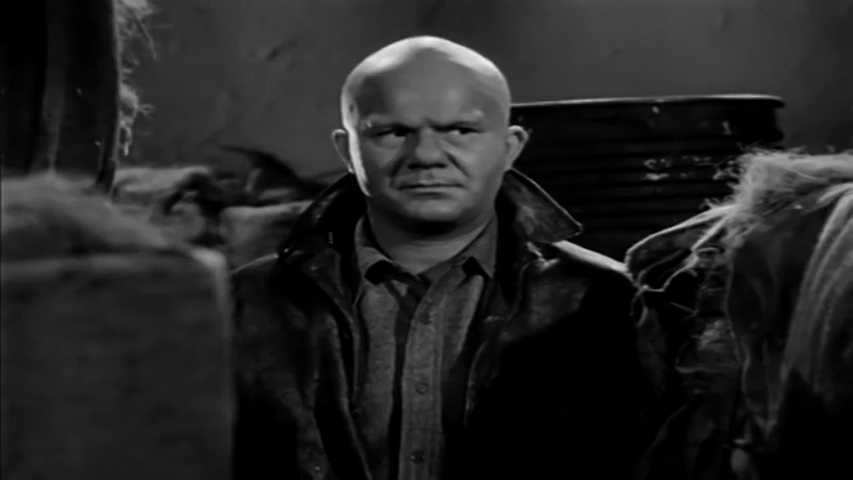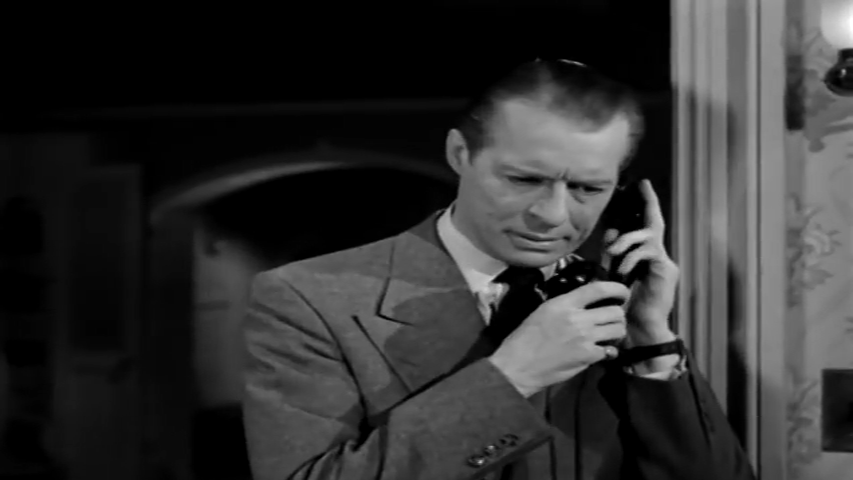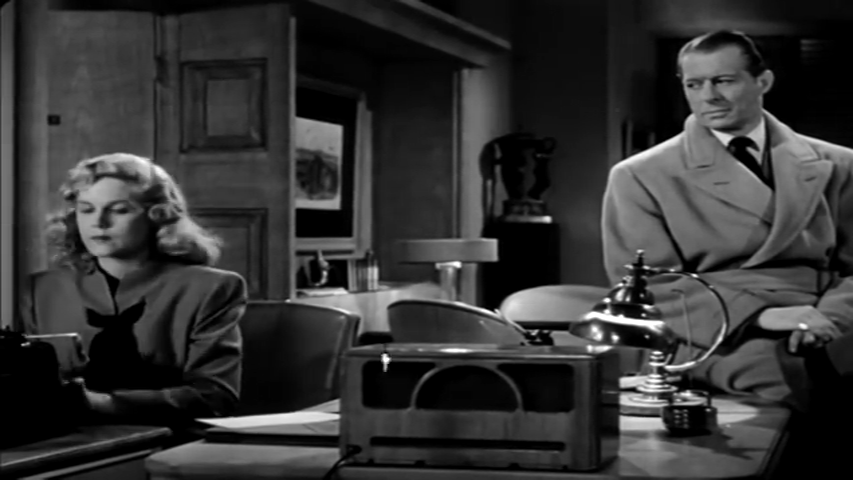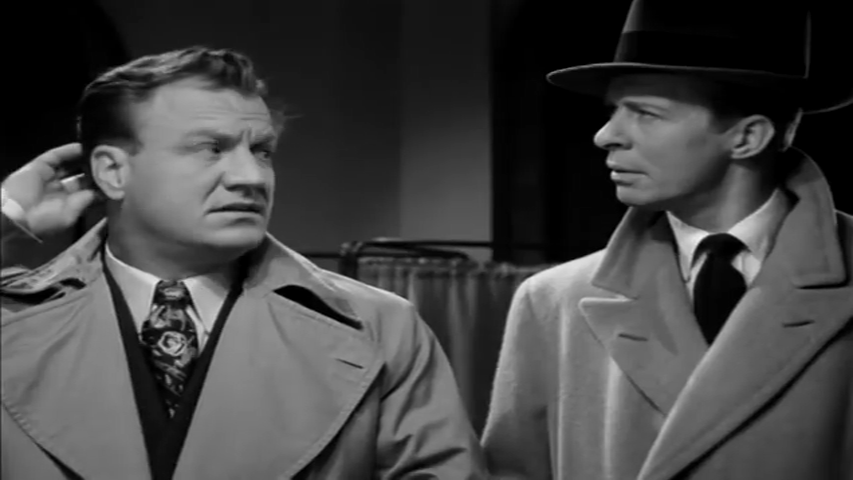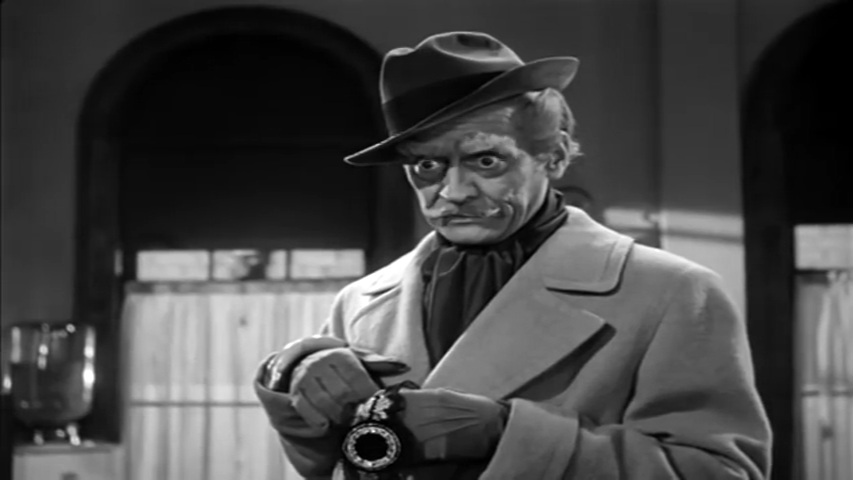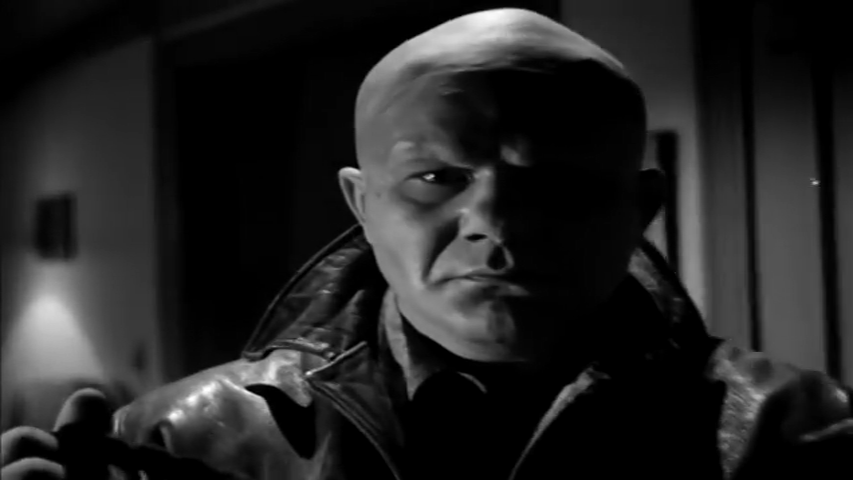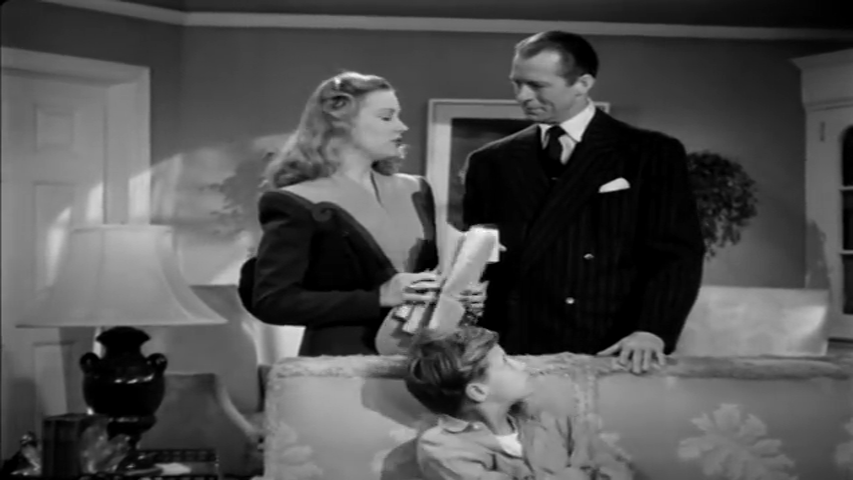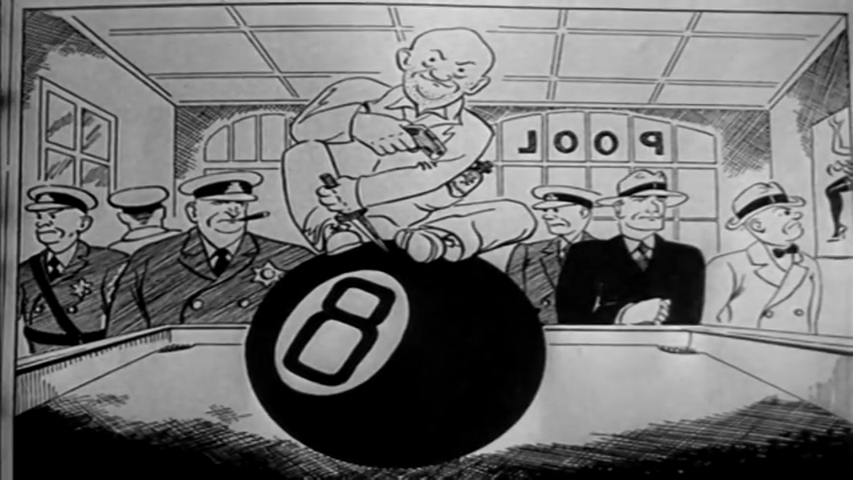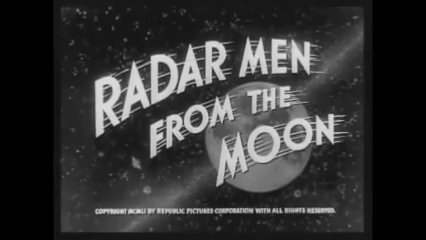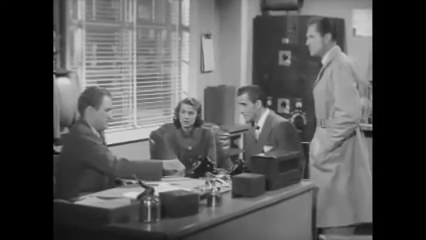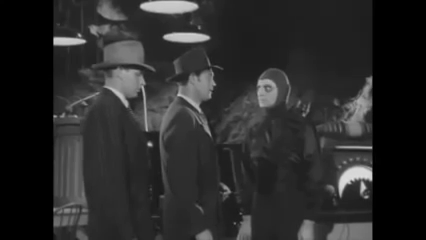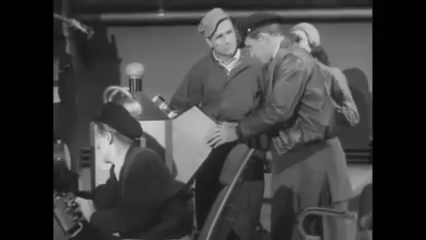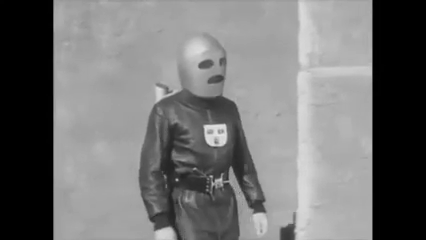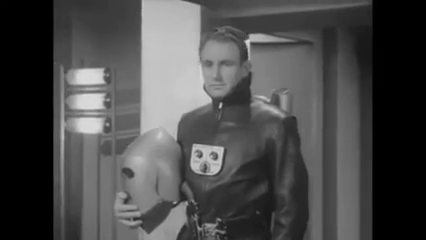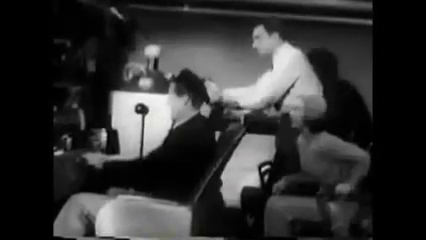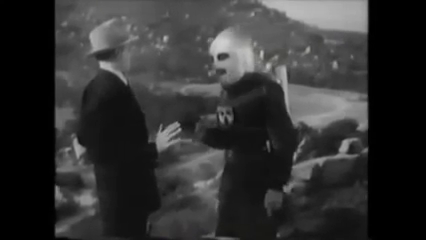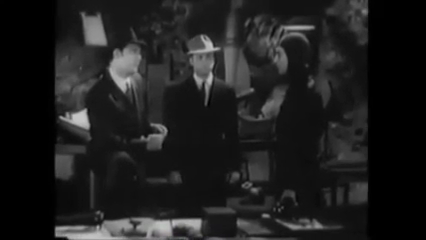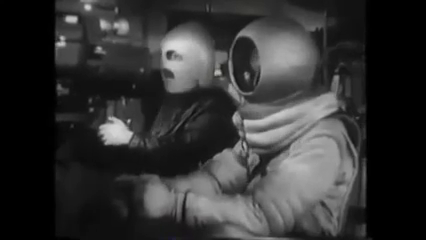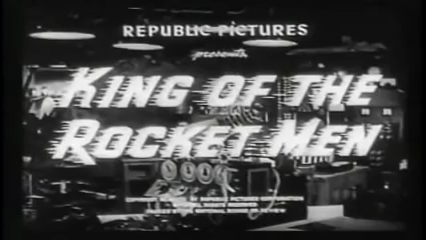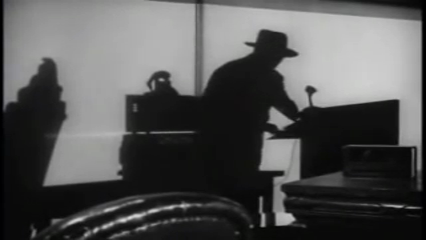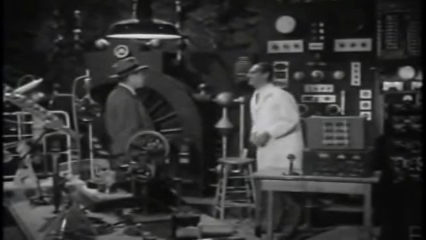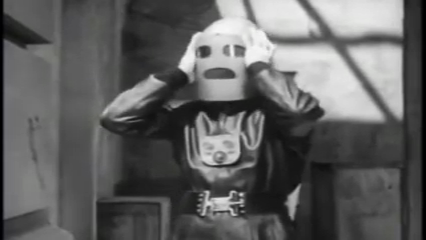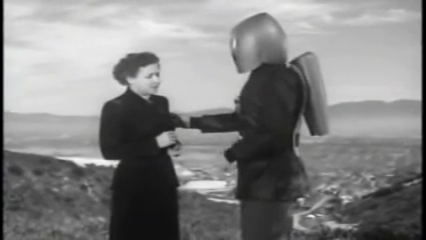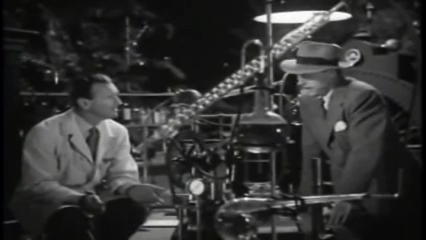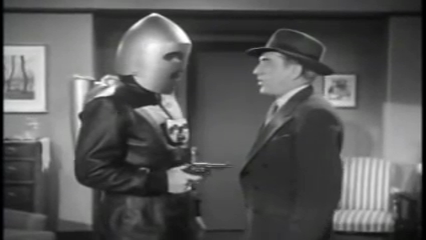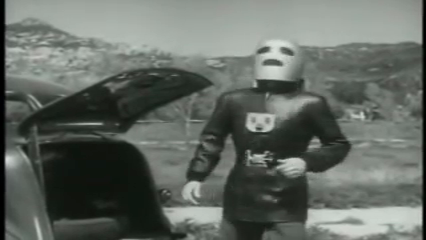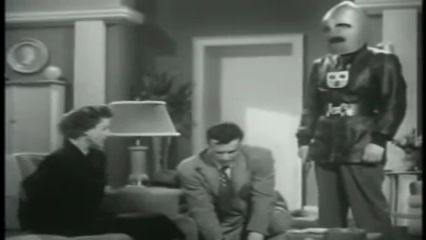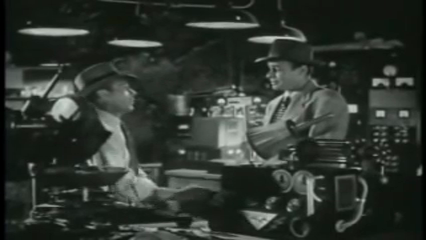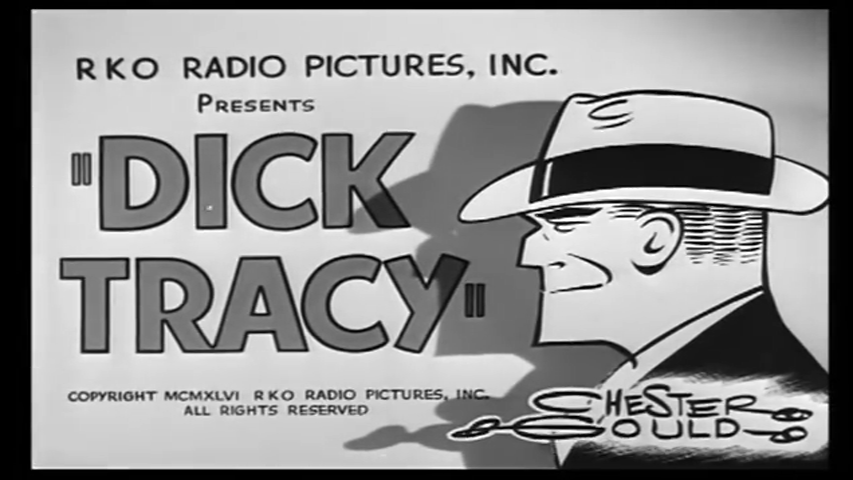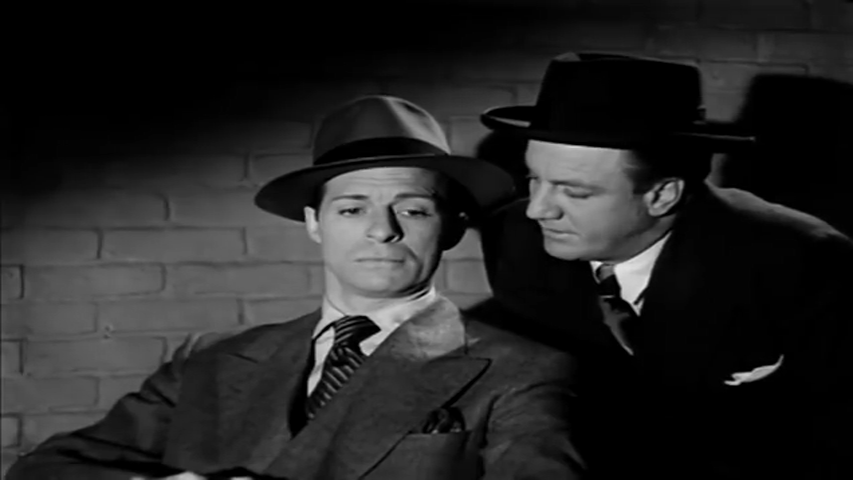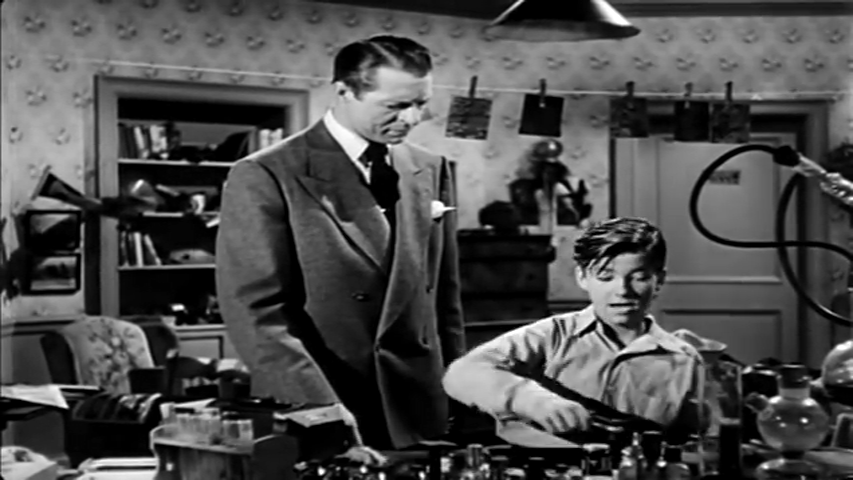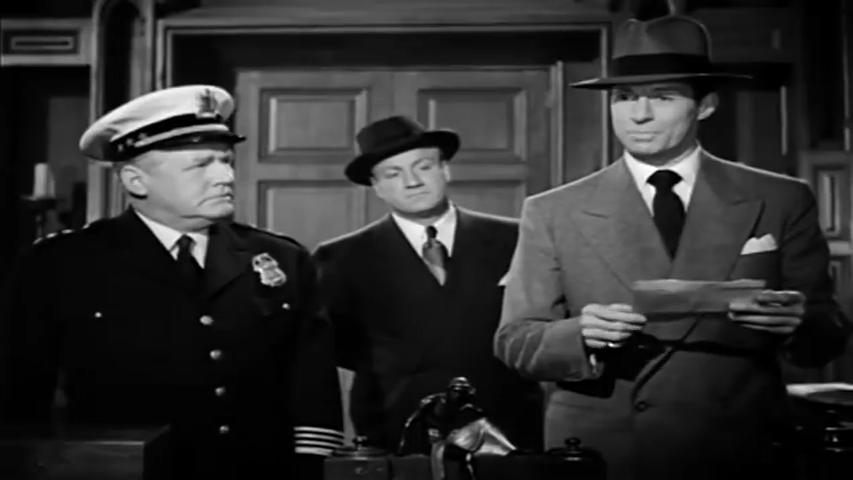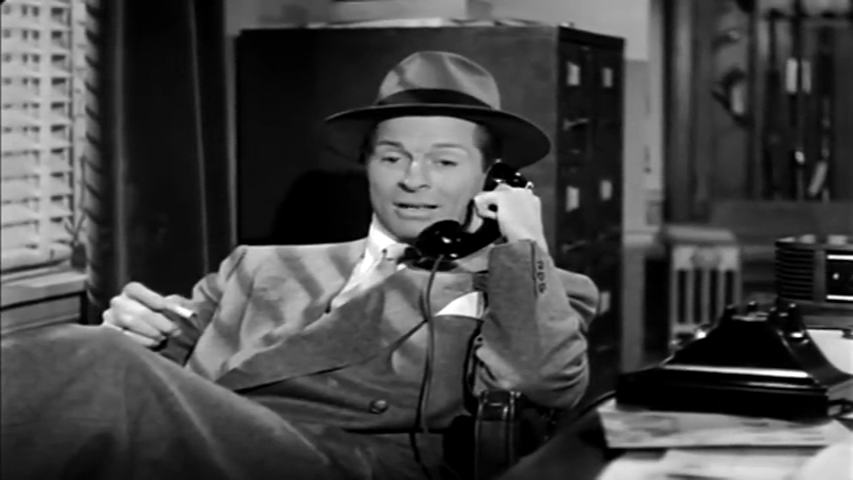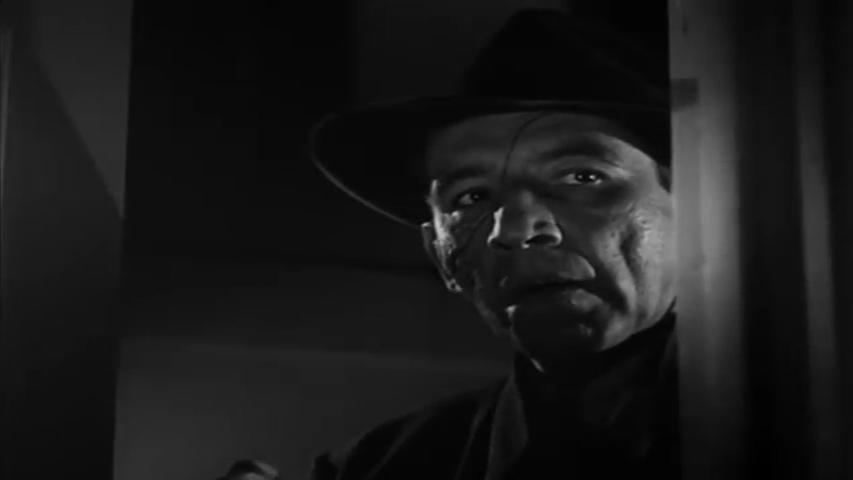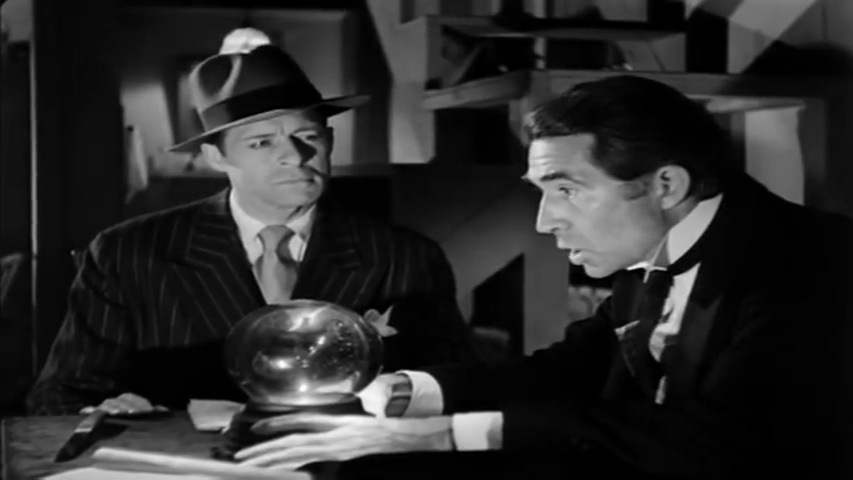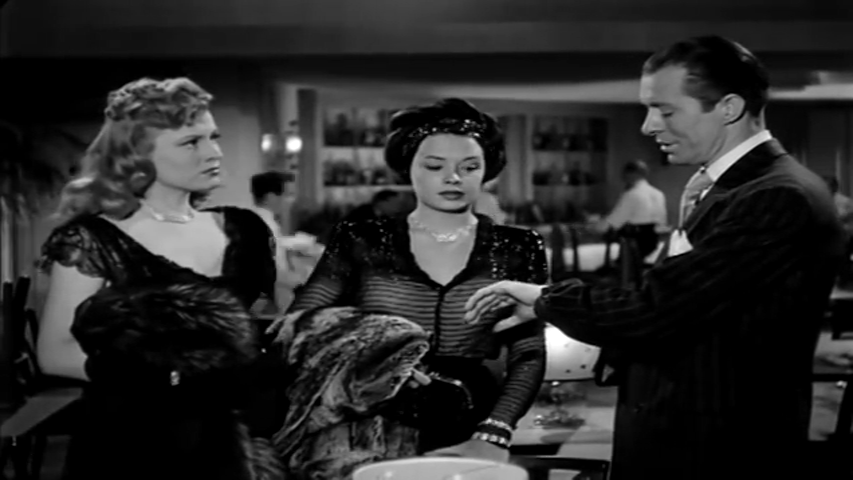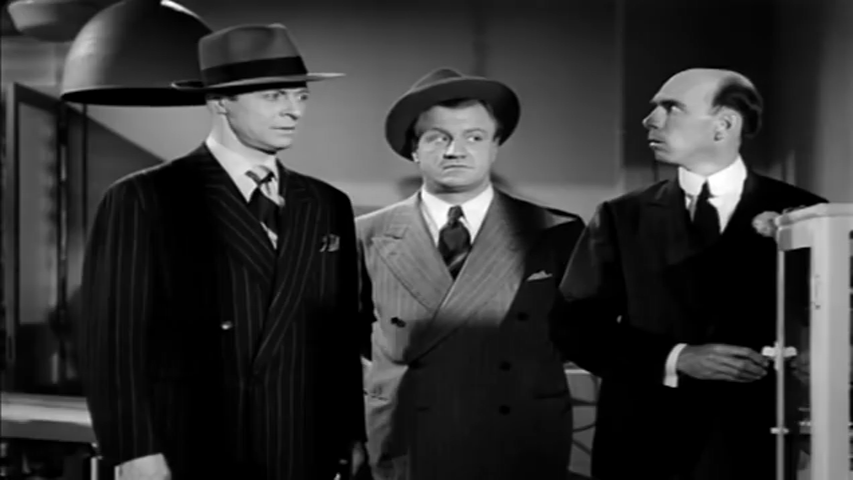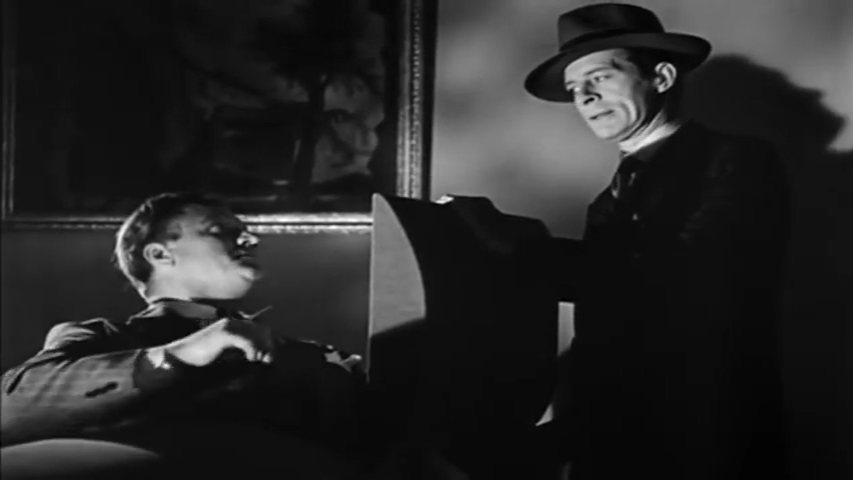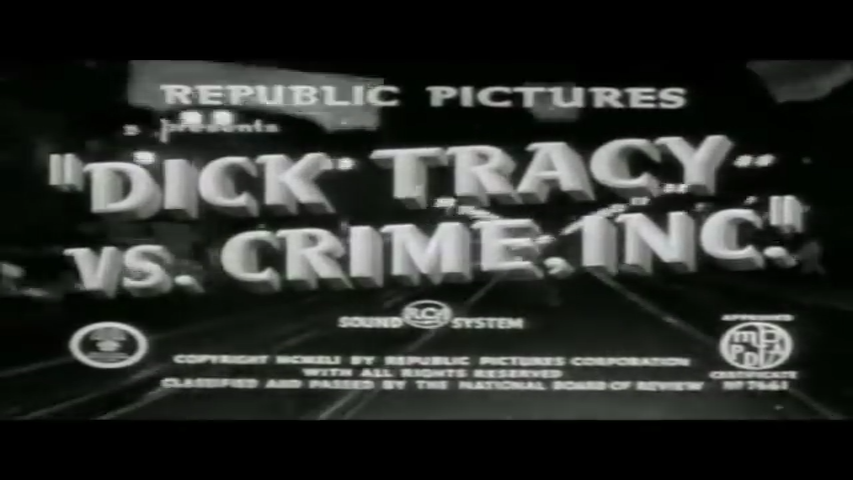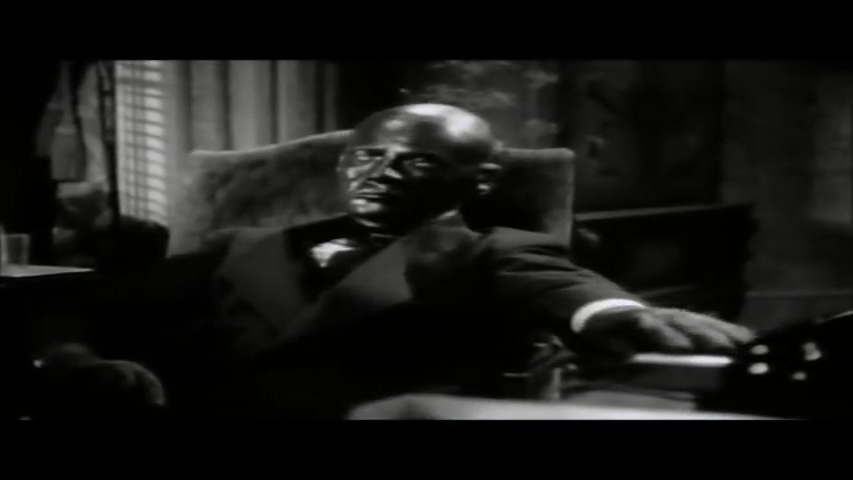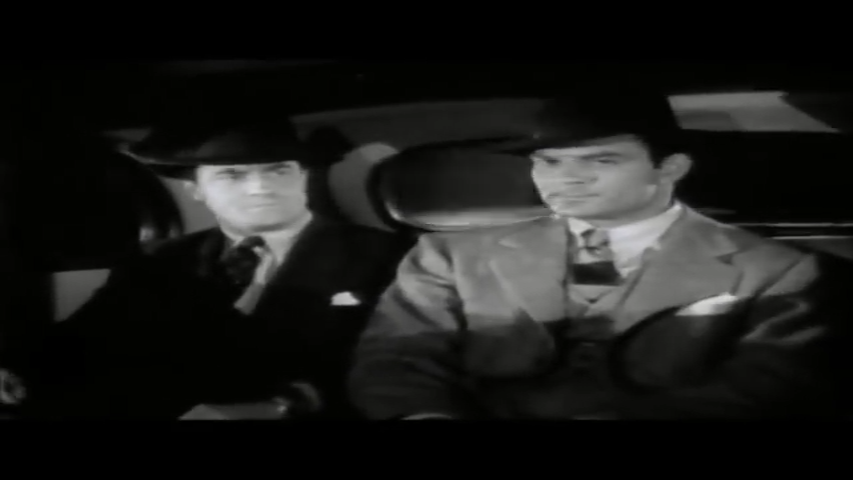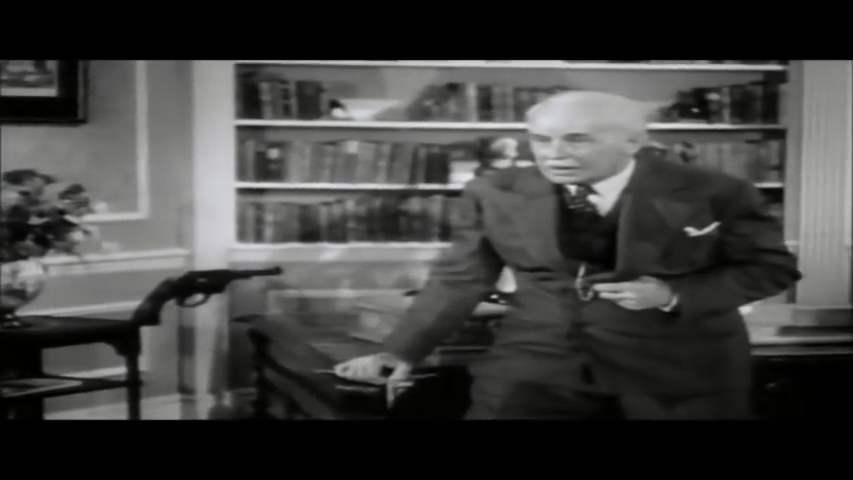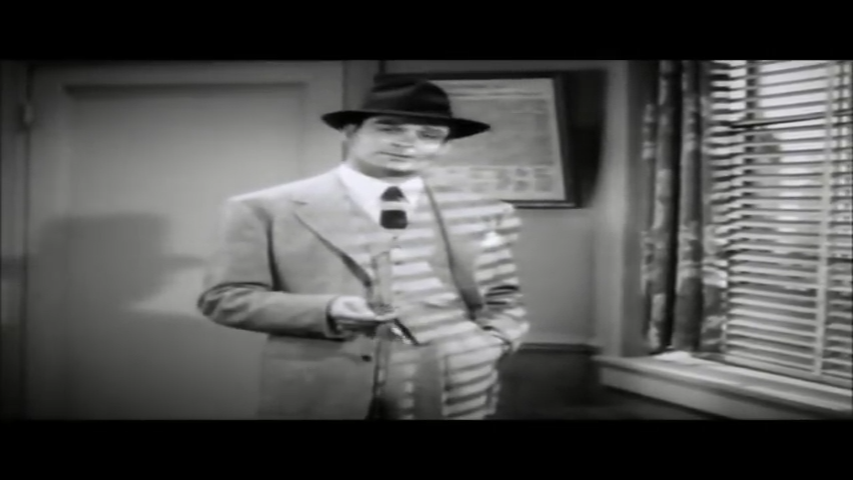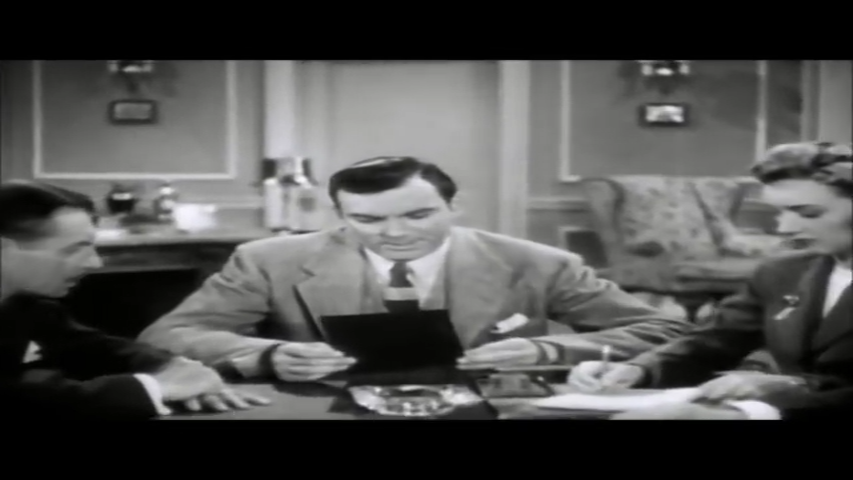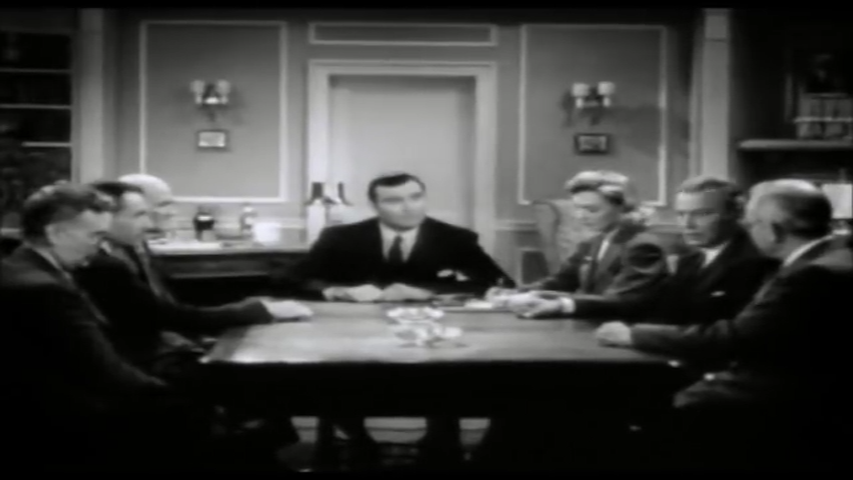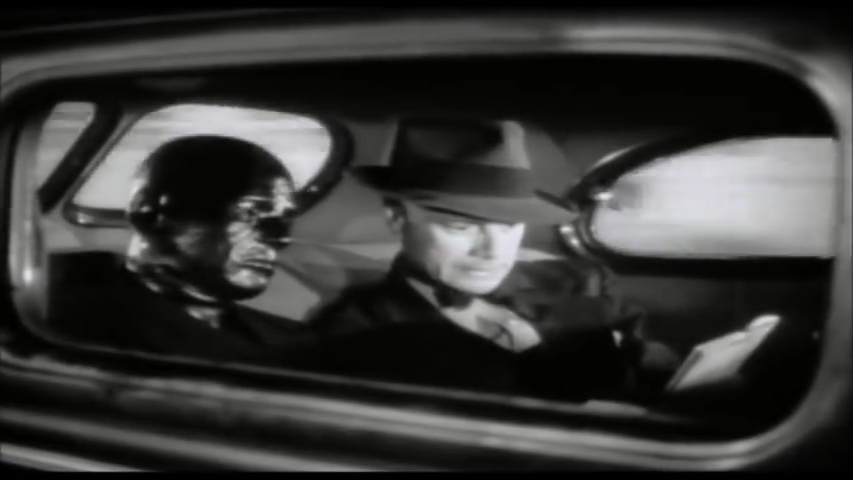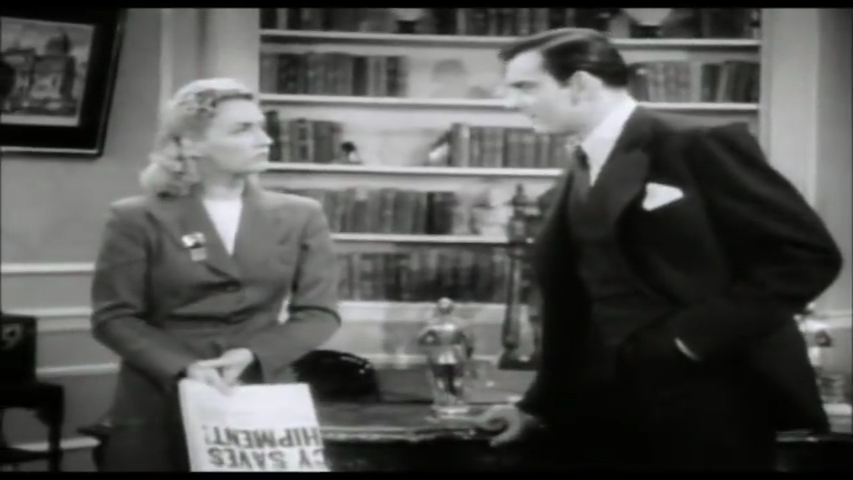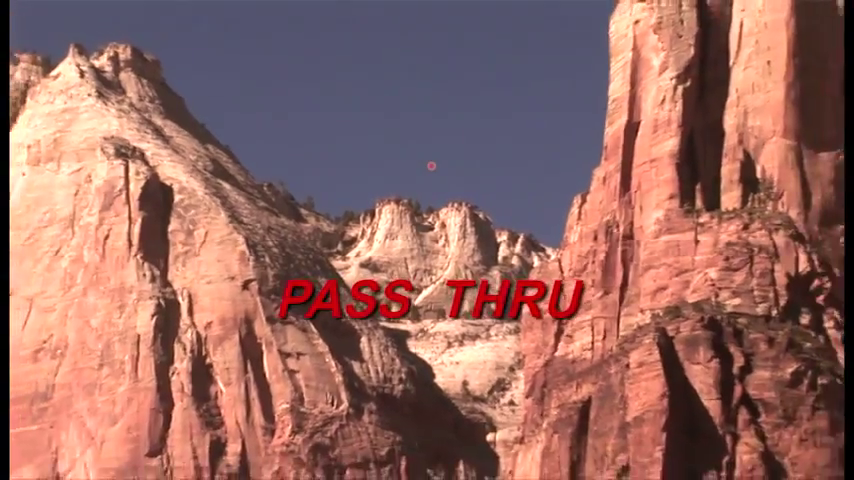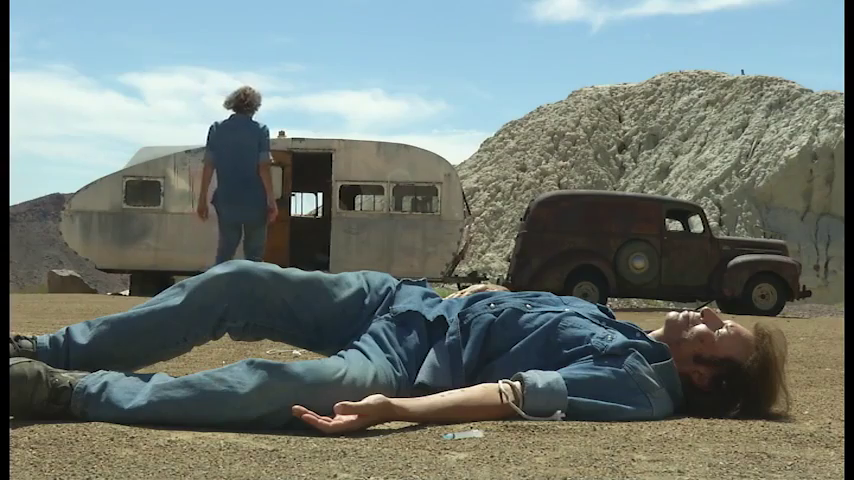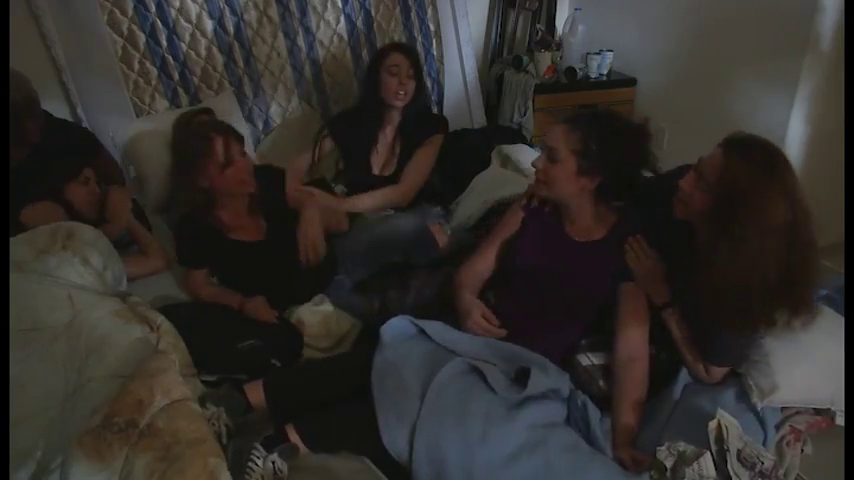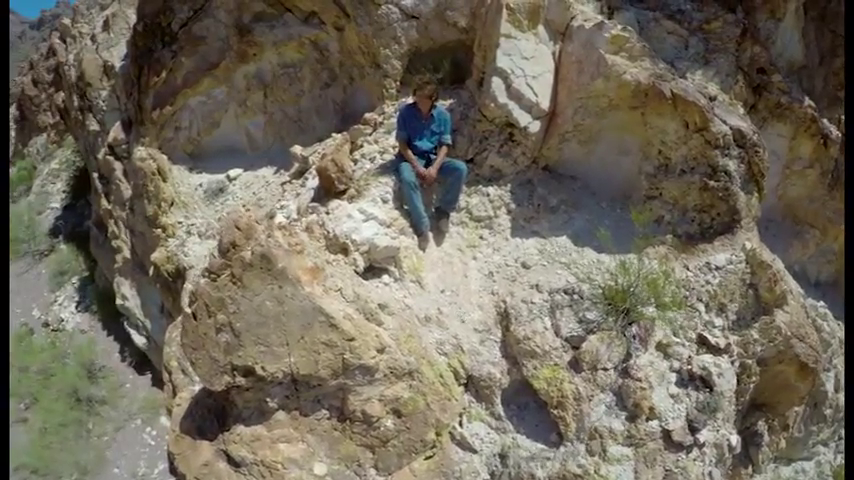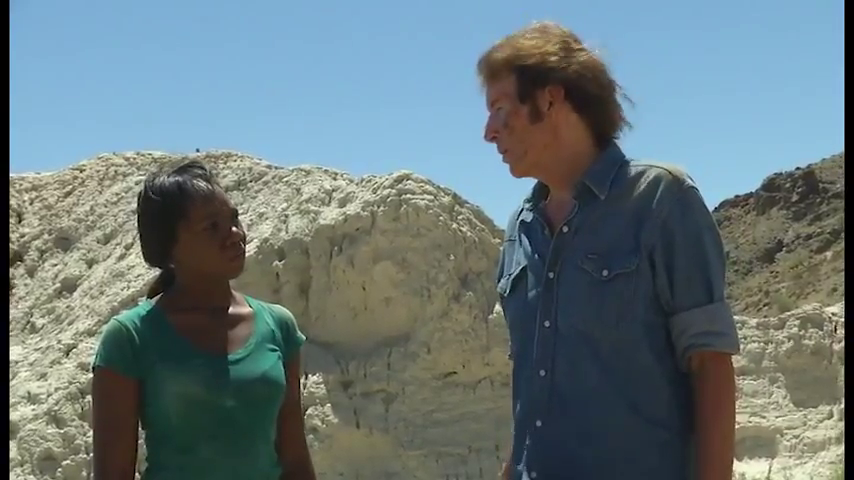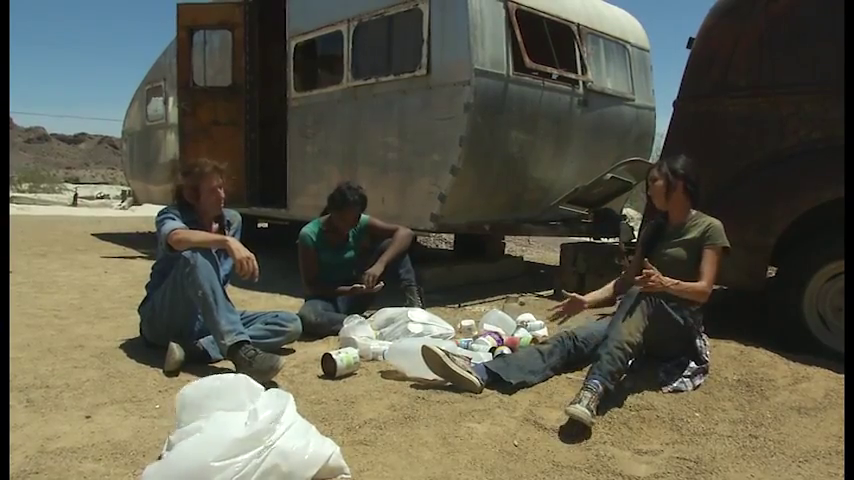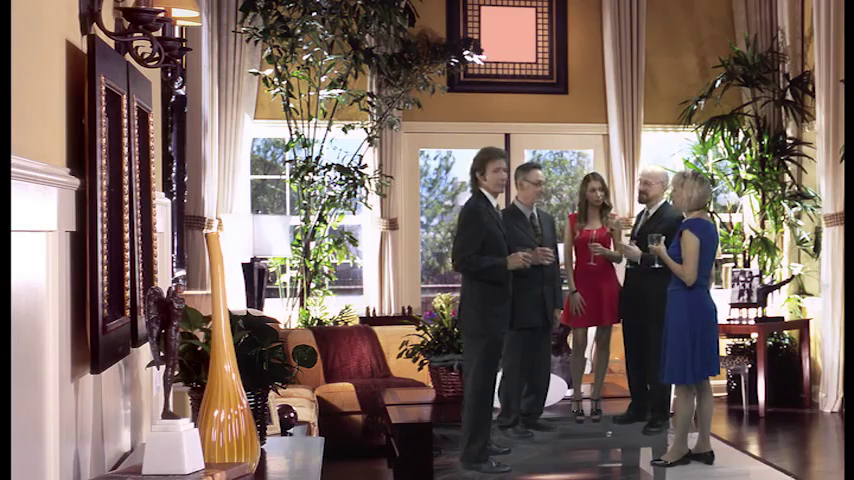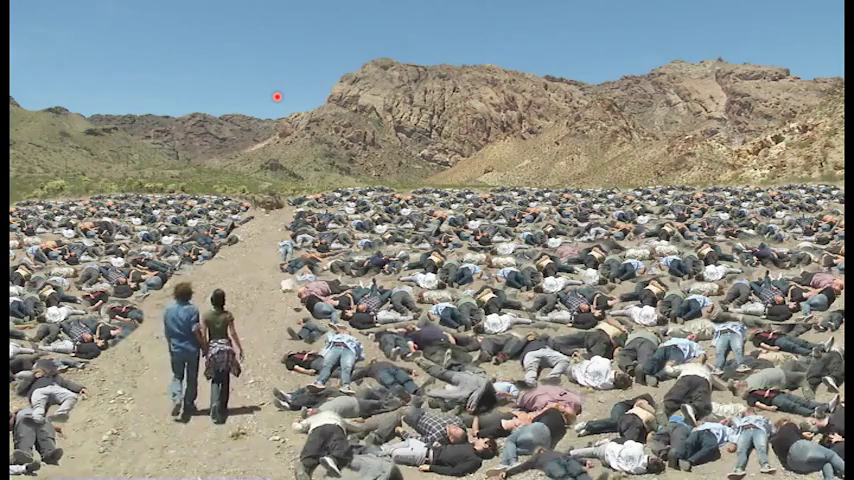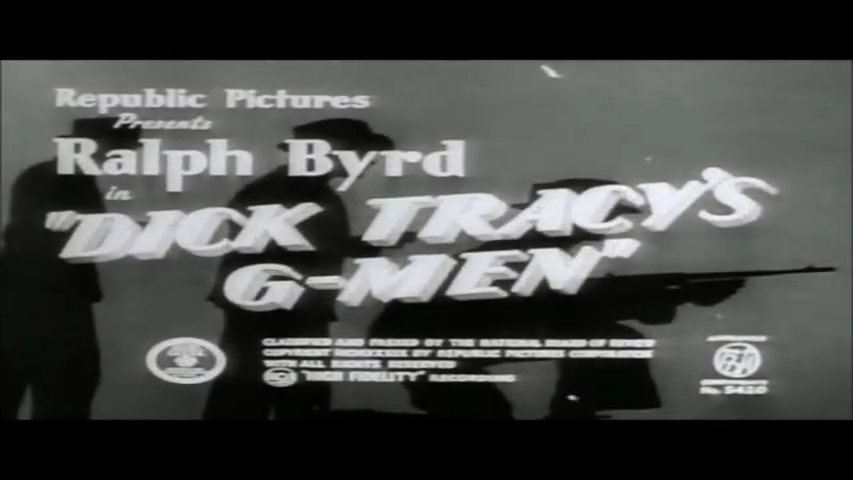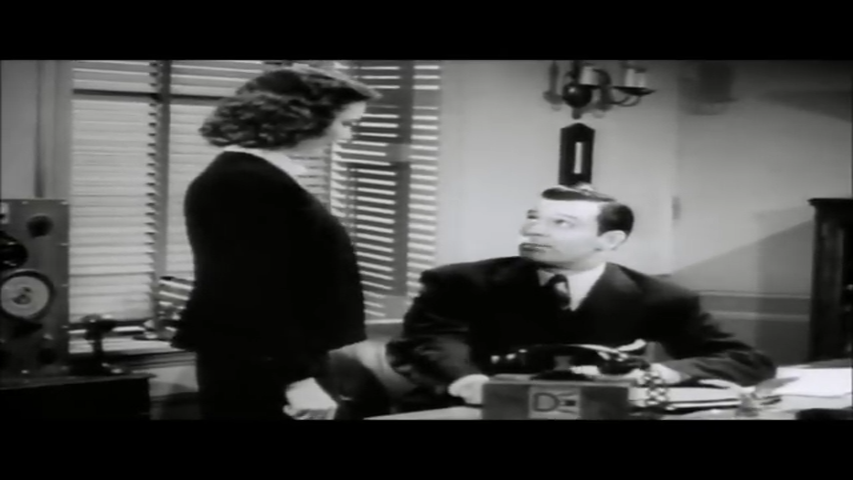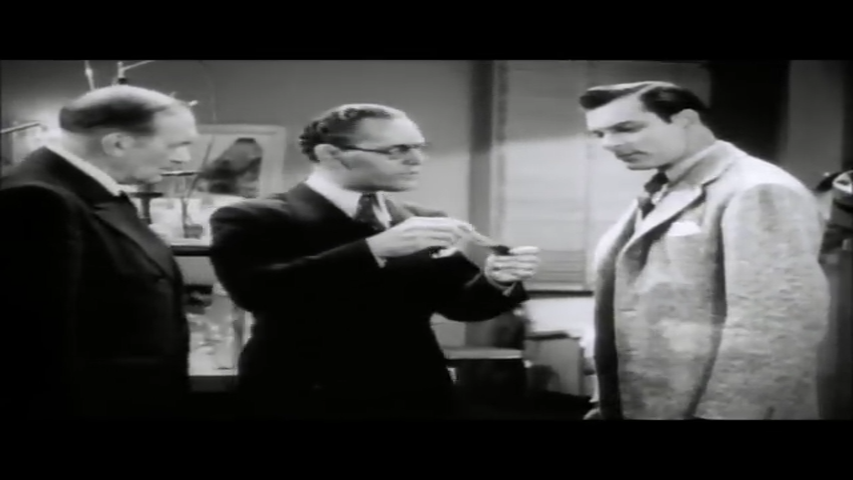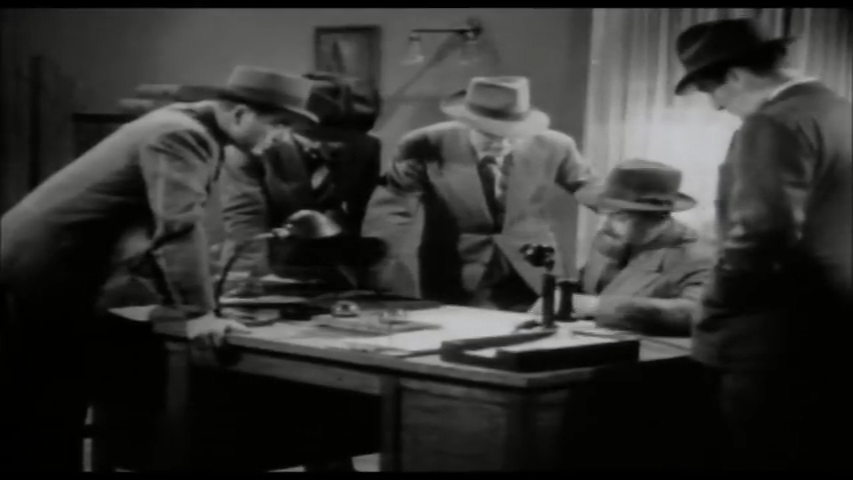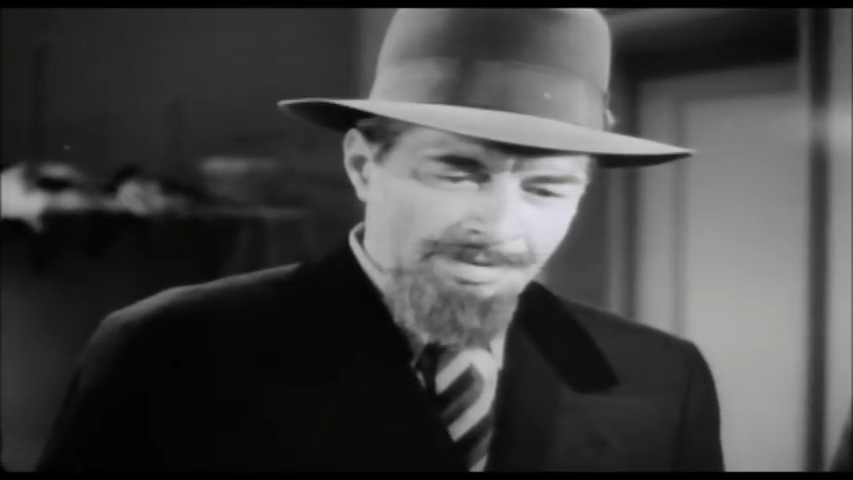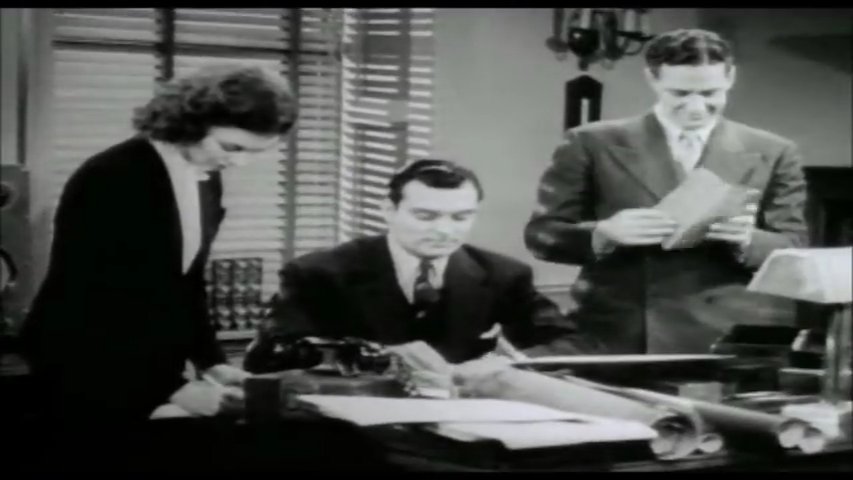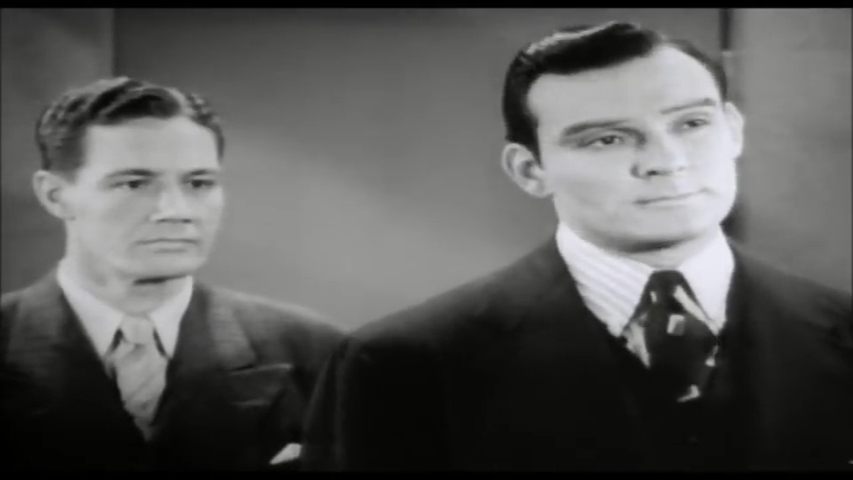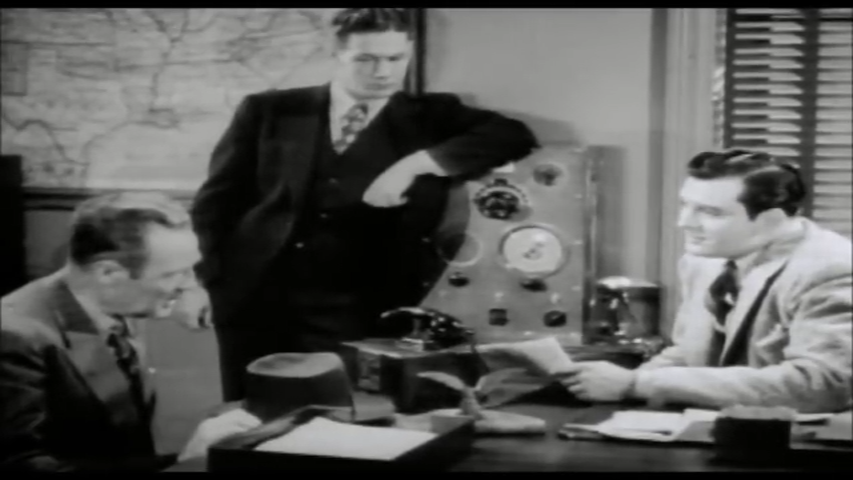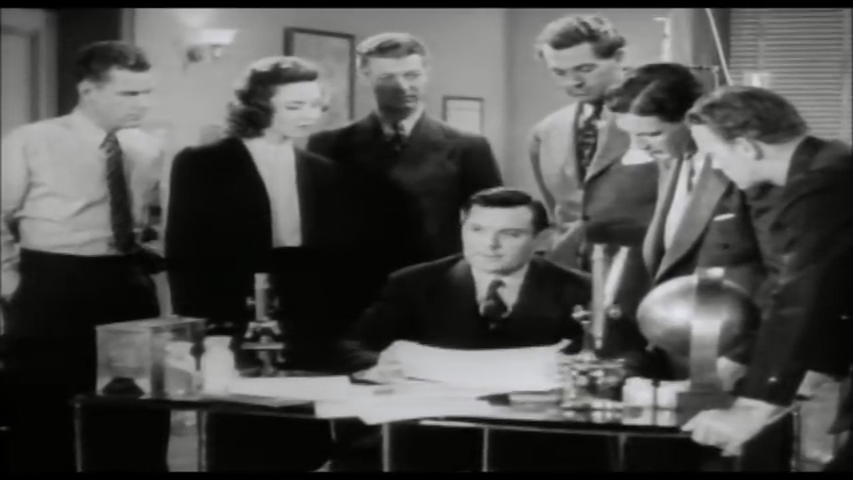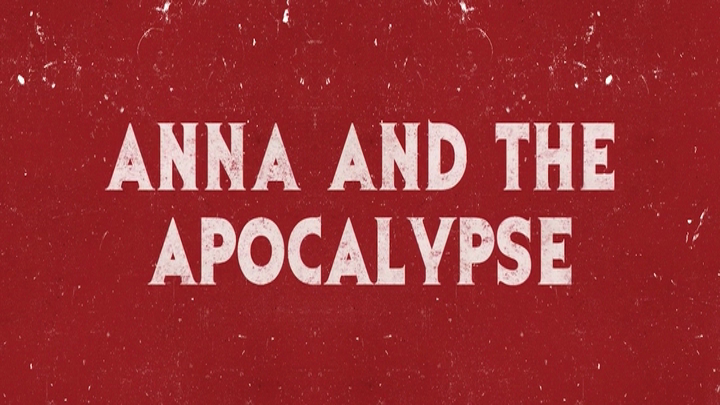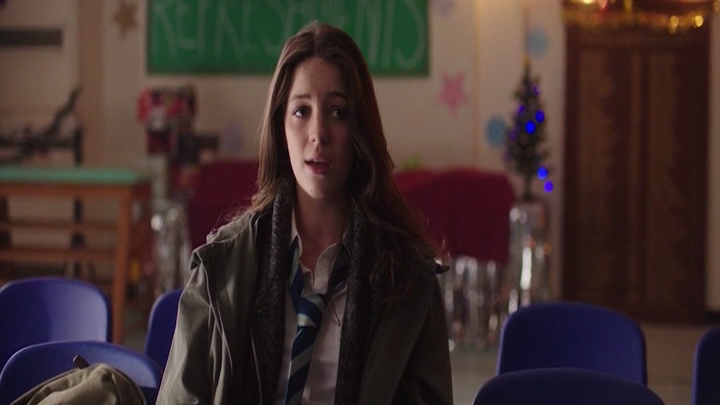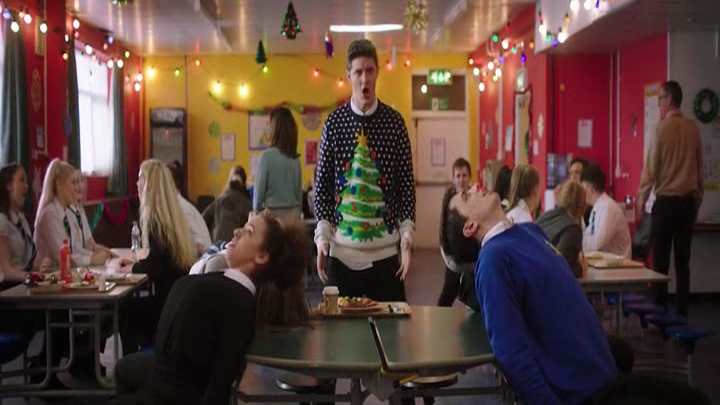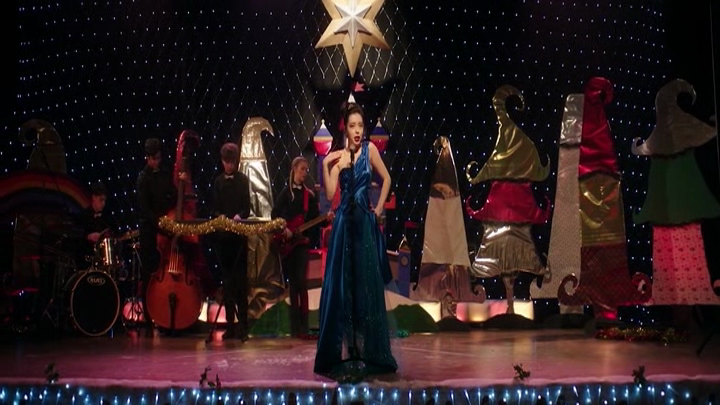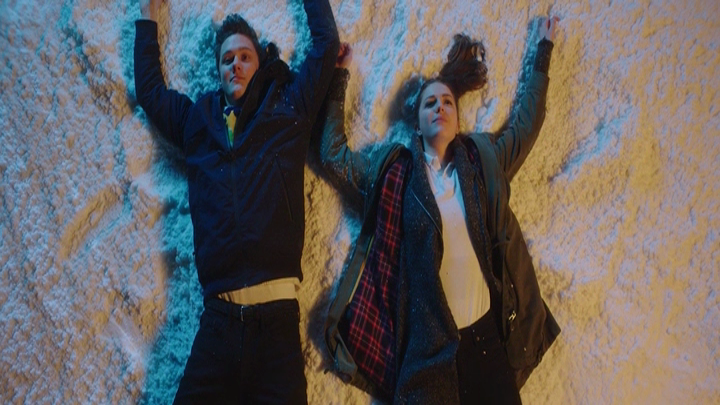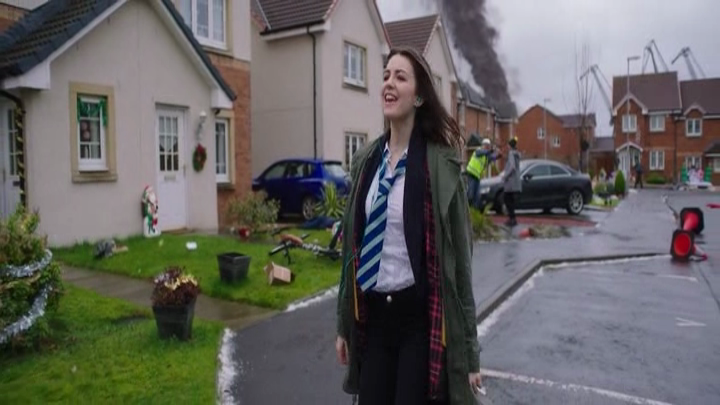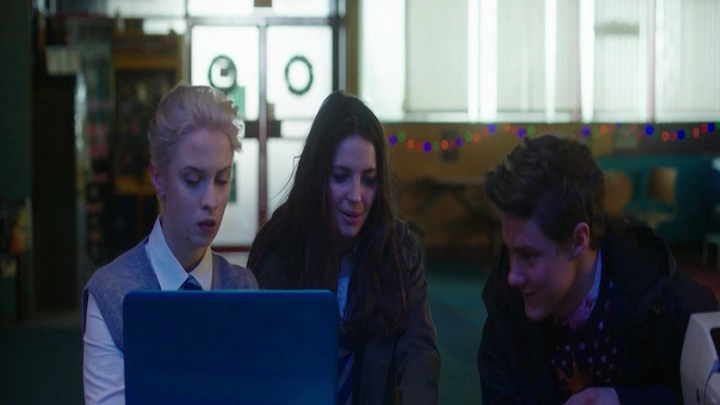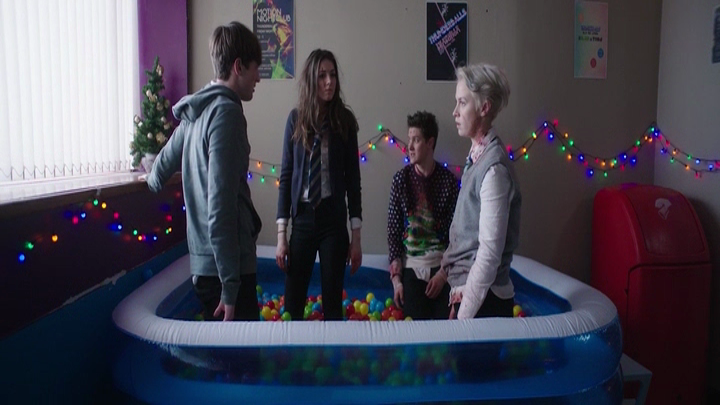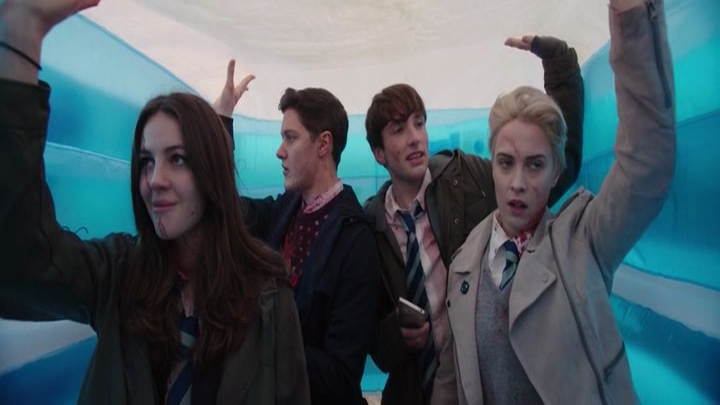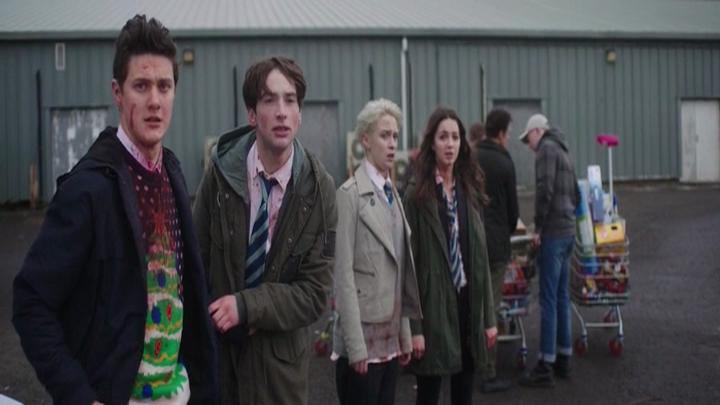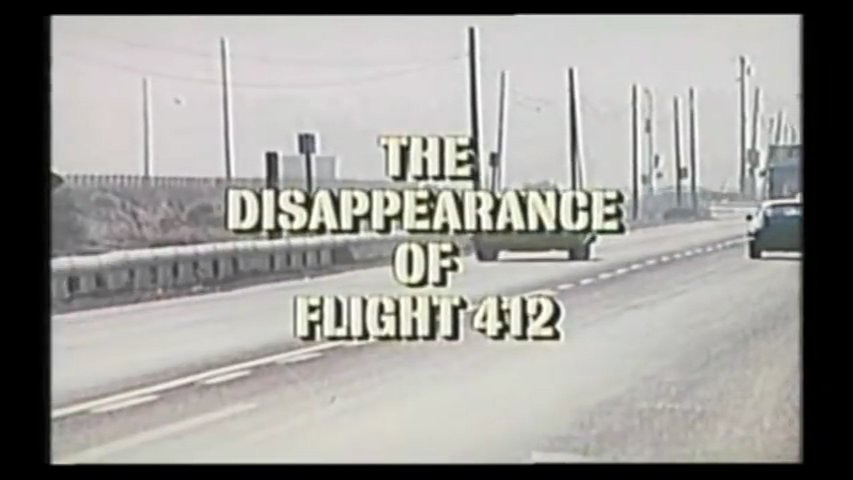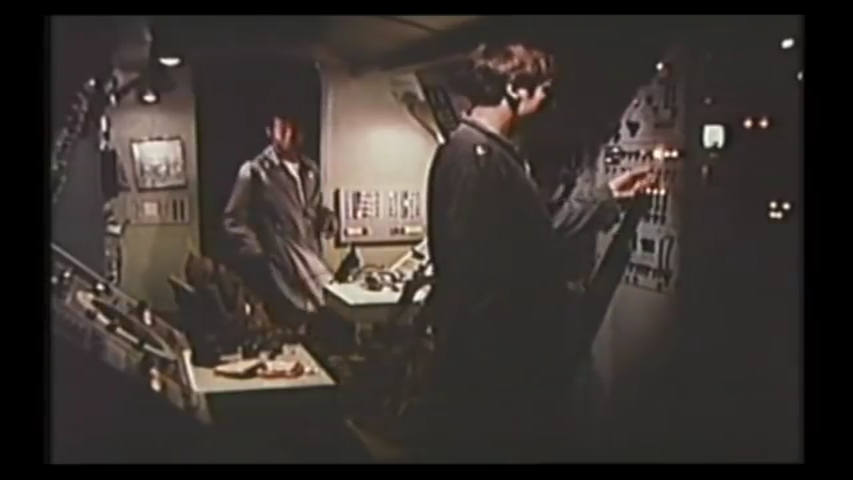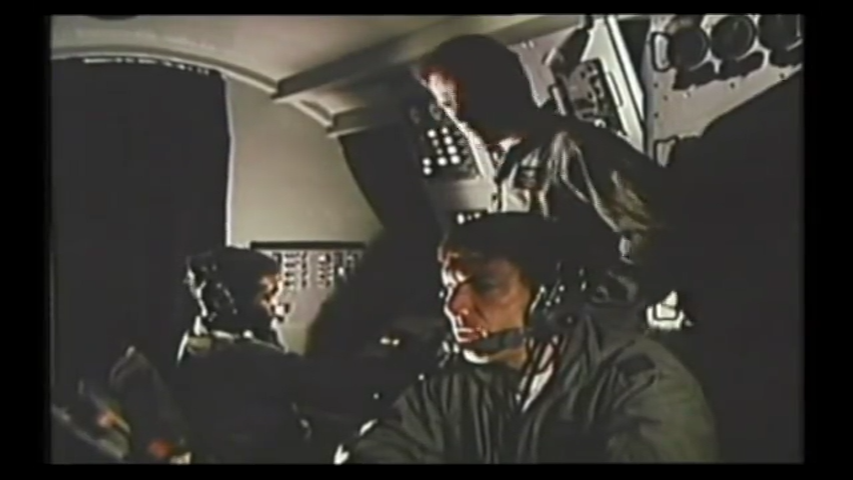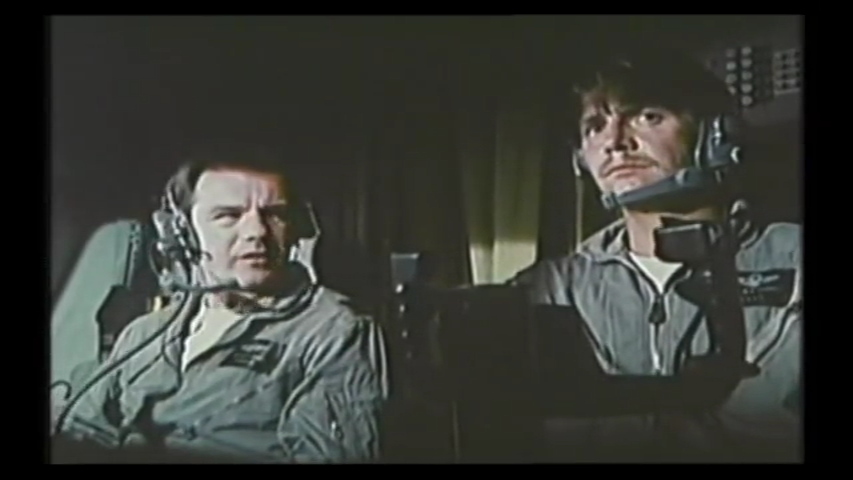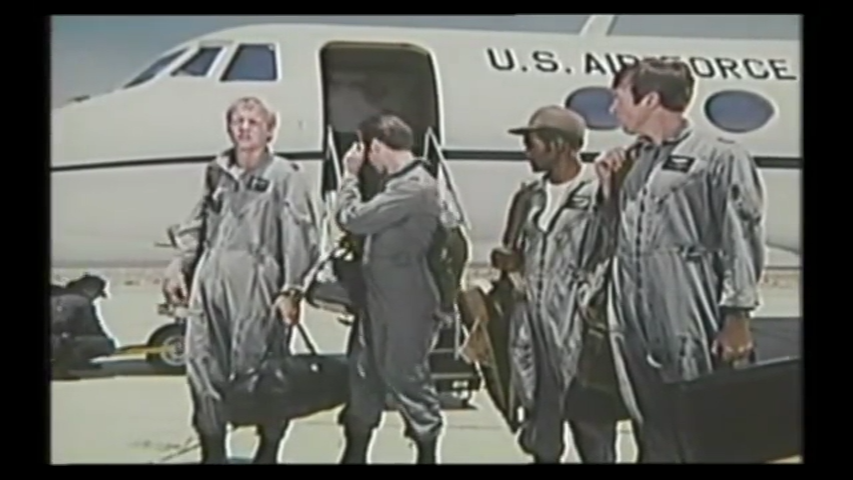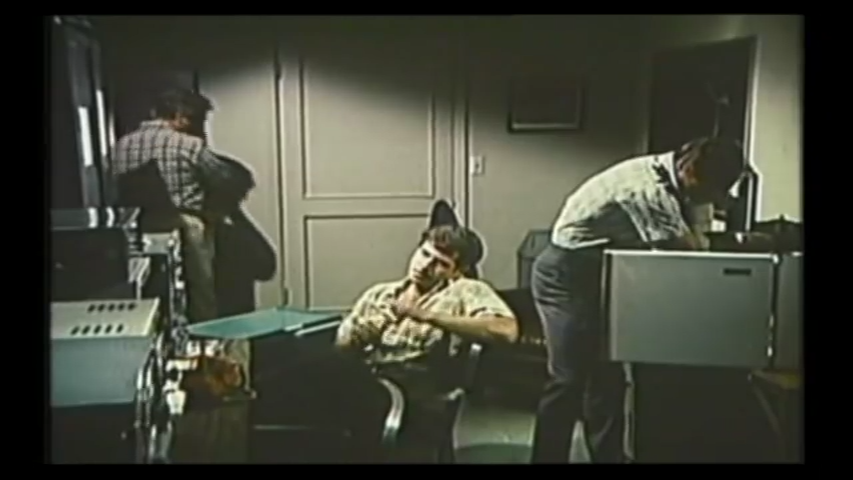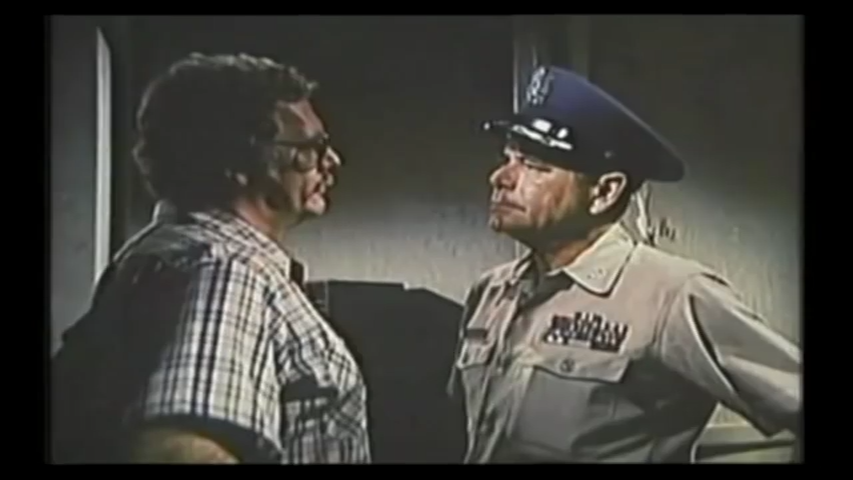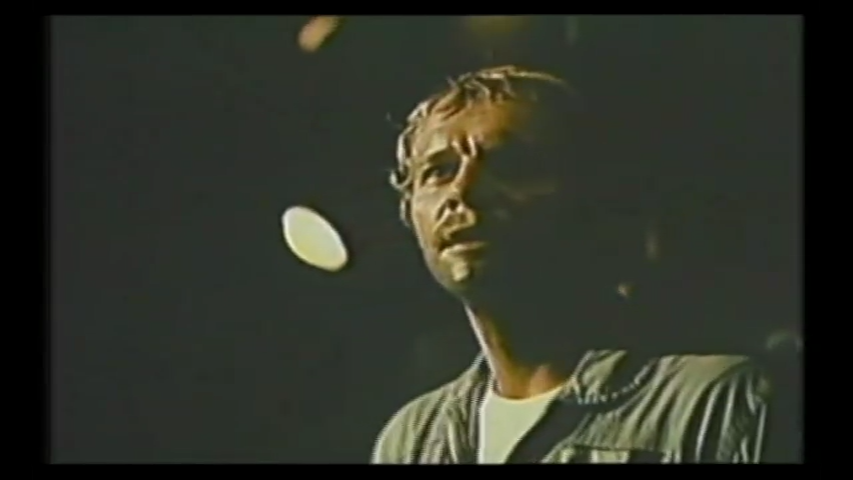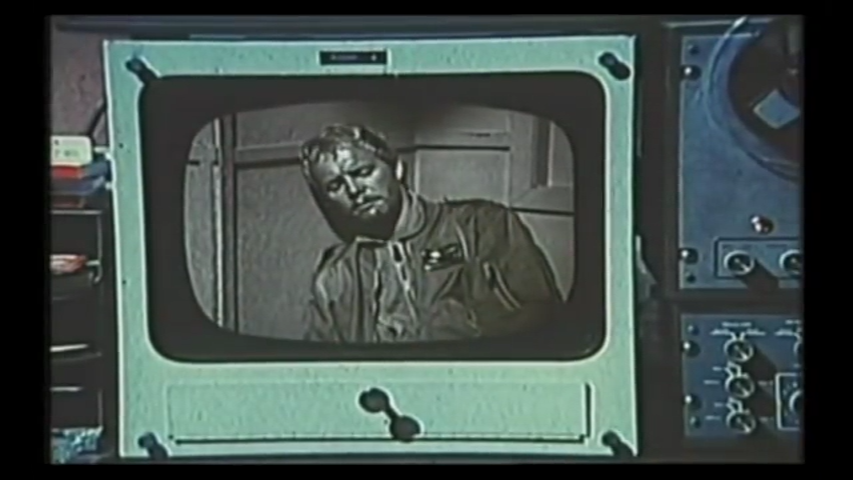-
#392 – The Purple Monster Strikes (1945)
The Purple Monster Strikes (1945)
Film review #392
Directors: Spencer Benet, Fred Bannon
SYNOPSIS: A rocket ship from the planet Mars makes a landing on Earth, and the astronomer Professor Layton goes to investigate. he finds a man from Mars as the only passenger on the ship and takes him to his observatory, where he learns the man is actually the first part of an invasion force come to conquer the Earth. After killing Layton, he has the ability to possess his dead body and attempt to get his prototype rocket ship design finish so he can use it to return to Mars and lead the invasion. The only person that can stop him is Layton’s assistant Craig Foster, accompanied by Layton’s niece Sheila.
THOUGHTS/ANALYSIS: The Purple Monster Strikes is a 1945 movie serial. The opening chapter sees a rocket ship crashing to Earth and Professor Layton going to the impact site. There he finds a man from Mars who it turns out to be the first of an invasion force sent to conquer the Earth. The Martian kills Layton and through the use of gas from the Martian atmosphere, is able to possess Layton’s dead body whenever he wants, which he does in order to get Layton’s rocket ship prototype finished, which is the final key to the invasion, as the Martian rocket ships are unable to return to Mars. Learning of the plans of the “Purple Monster”, Layton’s assistant Craig Foster and Layton’s niece Sheila must find a way to foil the Purple Monster’s plan to steal the rocket ship plans. The story unfolds in keeping with almost every other film in the serial format, with each chapter presenting a new scheme from the Purple Monster and Craig and Sheila attempting to foil it. The ability of the Purple Monster to possess Professor Layton’s dead body is a little dark, but it keeps it family-friendly by not dwelling on the details too much. The back-and-forth between the Purple Monster and Layton also adds an interesting dynamic between the characters. The cliffhangers at the end of each chapter are quite ambitious too, and full of high speed chases and explosions. You always know that they’ll result in someone escaping death at the last second, but it still puts some effort into pulling it off.
The characters themselves are a pretty dull bunch. The usual archetypes are all here: the main young white cowboy-esque hero, the token woman, the scientist, the mysterious villain and his henchman: there is nothing inspiring about any of them. We sometimes see the Martian emperor being contacted by the Purple Monster, and his assistant shows up near the end, but neither of them really offer anything exciting or interesting. The whole business with the Purple Monster being able to possess Layton really ties in with one of the main tropes of these serials of the enemy spy hiding in plain sight, and who could be anyone, which really ties into the paranoia around enemy spies in the U.S. during wartime. Other than that though, the cast is rather forgettable.
Overall, while The Purple Monster Strikes has some good special effects and fast-paced action scenes, its characters are dull and bland, and fail to stand out in the format. I think it sits comfortably in the middle of these serials: nothing special, but nothing catastrophically bad either. Being directed by two of the most prolific serial directors, Spencer Bennet and Fred Bannon, they certainly knew what they are doing, but they’re obviously doing it to create a stable source of income rather than trying to innovate at this point into the format’s history.
-
#391 – Dick Tracy vs. Cueball (1946)
Dick Tracy vs. Cueball (1946)
Film review #391
Director: Gordon M. Douglas
SYNOPSIS: Police detective Dick Tracy is called to a murder scene on board a ship where a jeweller has been strangled and a valuable set of diamonds has been stolen. As he continues to investigate, he uncovers a conspiracy involving multiple people to sell the diamonds, and must apprehend the man known as Cueball, who is killing off the people involved…
THOUGHTS/ANALYSIS: Dick Tracy vs. Cueball is a 1946 crime-noir film and the second Dick Tracy feature film. As the film opens, we see a boat docking into port when a thief breaks into a jeweller’s cabin, killing him and stealing the diamonds. Dick Tracy is called out to investigate the murder, and suspects a much larger conspiracy to re-cut and sell the diamonds. The story follows the investigation through all its twists and turns, and it is a story that is easy enough to follow while having enough interesting developments to keep one’s interest. At just over sixty minutes, it is not a long film, but it still feels full of content along with offering a complete experience. There’s not too much else to say different than what I wrote for the review for the previous film: its’s more of the same, mixing comic book characters with the crime-noir setting resulting in an easy to follow story, but an entertaining one at the least. Unlike its predecessor though, this one feels a little more down to earth, without the odd mystical elements that didn’t quite belong or go anywhere.
The protagonists from the first film all return, and as there, each of them feel a little like the comic book characters they are based on. The various suspects too have their own particular appearances and personalities, and it’s fun watching them all interact with each other. Everybody has something going on or a role to play, and no one feels wasted. The main antagonist, Cueball, definitely feels very menacing, and a genuine threat throughout, made even more menacing by the use of lighting throughout in typical crime-noir fashion. Tracy’s assistant Pat Patton provides a bit of comic relief, along with the young Junior, and Tracy’s girlfriend Tess Trueheart also gets a role to play in the investigation. Overall, Dick Tracy vs. Cueball is very similar to its predecessor released in the previous year, but also manages to make some improvements by tightening the story, making it flow better, and making the villains more menacing. It’s not an exemplary example of the crime-noir genre, but it’s a good combination of it with the comic strip characters and personalities that gives it a bit of a unique flair. If you enjoyed the first one, you will certainly enjoy this one too.
-
#389 – Radar Men from the Moon (1952)
Radar Men from the Moon (1952)
Film review #389
Director: Fred C. Brannon
SYNOPSIS: After a series of devastating attacks across the planet, Commando Cody is assigned to travel to the moon in a rocket ship to investigate the theory that the attacks are being launched from there. While there, he finds that the ruler of the moon Retick has been ordering the attacks in order to pave the way for a full scale invasion of Earth, and only Commando Cody and his friends can stop it…
THOUGHTS/ANALYSIS: Radar Men from the Moon is a 1952 movie serial comprised of twelve chapters. The first chapter opens showing aerial attacks across the globe, destroying vital infrastructure. Commando Cody and his friends are visited by a government official who believes that the attacks are originating from the moon. Cody has also come to the same conclusion and coincidentally his friend ted has just finished building a rocketship that can fly to the moon. Cody and his friends travel to the moon to investigate, where they find the leader of the moon, Retik, has ordered the attacks to prepare for a full-scale invasion as the moon’s atmosphere is evaporating and making it uninhabitable. Cody manages to steal one of their ray guns and take it back to Earth, while one of the Moon’s inhabitants, Korg, who is stationed on Earth, tries to get the ray gun back and stop Cody along with his hired goons. The fundamentals of the story have been done in many serials before (Flash Gordon, Brick Bradford etc.) so it’s nothing really original, and it’s got all the usual action scenes, chases, cliffhangers and the like. I’ve reviewed so many of these serials now they all somewhat blend into one, and it takes something special to draw my attention. As I have mentioned before, this is the sort of thing you could get away with at the time, as there was no home media or way to rewatch them, and as these are mostly aimed at a younger audience, they may not have seen the older ones, so it was easy to get away with it. With the onset of television at this time though, people could start watching this serial format at home rather than going to the theatre every week, so serials would become less and less popular, although not too many people would have televisions, so the serial format had a few years of life yet. By this time though, the tropes of the format had been well and truely done to death.
This serial is the first to feature Commando Cody, who would have another serial a year later. The flying rocket suit he uses however, was featured in the 1949 serial King of the Rocket Men. There’s no continuity between the two, but as mentioned the younger audience would probably not have watched the previous serial, but may recognise the imagery, as it was quite a unique suit, and the flying mechanics and effects were something new. Radar Men from the Moon re-uses a lot of the rocket suit footage from that film of him flying through the air and such, which again it could be gotten away with at the time. The rest of the characters are the usual cast for the format: one female, a sidekick, the villainous henchman and the alien leaders dressed in bizarre clothing so you know they are alien. There’s some interesting props and sets when the cast are on the moon, with vehicles and underground bases, but that’s the only thing that really stands out. Overall, Radar Men from the Moon is just another standard sci-fi serial. Nothing horrifically bad about it, but nothing to set it apart from all the others that do the exact same thing. Just another one for the pile I guess.
-
#388 – King of the Rocket Men (1949)
King of the Rocket Men (1949)
Film review #388
Director: Fred C. Brannon
SYNOPSIS: A man calling himself Dr. Vulcan is killing off prominent scientists. After one such scientist, Dr. Millard manages to escape an attempt on his life, he goes into hiding and develops a rocket suit that allows the wearer to fly through the skies. He enlists fellow scientist Jeff King to wear the rocket suit and thwart Dr. Vulcan’s schemes.
THOUGHTS/ANALYSIS: King of the Rocket Men is a 1949 sci-fi serial. The story opens up with the mysterious Dr. Vulcan killing off members of the Science Associates, a group of top scientists. One such member, Dr. Millard, manages to escape one of Vulcan’s traps and goes into hiding, leading Vulcan to believe he is dead. While in hiding, Millard completes his invention of a rocket suit that allows the wearer to fly thanks to a jet pack. Millard enlists the help of Jeff King, another member of Science Associates to wear the suit and track down Dr. Vulcan. The story involves the usual serial tropes, with Dr. Vulcan’s true identity being hidden throughout the serial until the end, and with King figuring out the Vulcan is actually one of the members of Science Associates, he has to work out which one it is, which again is a familiar set-up for these serials. Some of the chapters provide a bit of variety, such as the one where King’s ally Ted suspecting King to be Vulcan and vice versa, which leads to an interesting confrontation, and one which I have not seen before in the serial format, but other than that its the usual back-and-forth between heroes and villains chasing each other down with various plans and traps.
The highlight of this serial has got to be the rocket suit, which allows King (and sometimes Millard) to fly through the air. This is the first serial of three to use the rocket suit, but the only to refer to the hero as “rocket man”. The other two, Radar Men from the Moon and Zombies of the Stratosphere, are all unconnected from one another, and do not give the masked hero a name. Since this serial like most is aimed at getting young viewers into the theatre each week for the next chapter, the rocket suit would definitely have been a hit with them, as there really wasn’t anything like it when it came out. Older viewers would perhaps have been less than engaged with all the usual tropes being wheeled out, but the serial isn’t really for them. There’s plenty of other inventions shown throughout the serial which are interesting enough to change up the pacing, but ultimately it does rely on the tried and tested serial elements.
The end of the film also deserves note, as in some sense the villain wins. Dr. Vulcan steals a device known as the Decimator, and uses it on a tectonic fault-line, causing a huge tidal wave that essentially destroys Manhattan. The footage of the tidal wave is taken from the 1931 film Deluge, in which a rising of sea levels causes most of the world’s population to be wiped out. The destruction looks good and devastating, and it still holds up despite being made nearly twenty years earlier, but obviously if you’ve seen it before it lessens its impact being used a second time here. Nevertheless, it’s very unlikely viewers of this serial would have seen it being used in Deluge due to the time elapsed and there being no re-runs or home releases back then. King manages to eventually stop Dr. Vulcan, but after New York City has been destroyed, and the serial ends with the ambiguous promise to rebuild New York ‘better than ever’. Not exactly a solid resolution, but these serial never are after investing nearly three hours watching them. King of the Rocket Men was released in 1949, after the serial format had peaked, but there were still some good ones being released (most notably the Superman serials, which were quite popular, and some of the best examples of the format). “Rocket man” is somewhat a superhero, with his flying ability and masked persona, and this no doubt would have made the serial stand out, but a lot of the other elements of the serial are pretty standard for the format. Overall it’s a little more interesting than the average serial, but not outstanding.
-
#387 – Dick Tracy (1945)
Dick Tracy (1945)
Film review #387
Director: William A. Berke
SYNOPSIS: Police detective Dick Tracy is investigating a series of murders carried out by a man calling himself “Splitface”. With plenty of suspects around, Tracy has his hands full trying to apprehend the killer, protect the mayor, and keep his girlfriend Tess happy…
THOUGHTS/ANALYSIS: Dick Tracy is a 1945 film and the first feature film in the Dick Tracy franchise, after the four serials made between 1937 and 1941. The film starts out with a murder of a teacher, which Tracy learns has been carried out by a man calling himself ‘Splitface,’ thanks to a note left by the killer demanding a ransom payment. As the film progresses, a number of suspects emerge, and Tracy must use all of his detective skills to work out who the murderer is. The film fits very much in the crime-noir genre, with the high contrast lighting and dark plot. It also evokes the original comic book style with its dramatic perspectives. The story is certainly more of a faithful adaptation of the comic book than the serials with Tracy being a police detective rather than a G-man as he was in the serials. More of the characters from the comic also make an appearance, which will probably be welcome to readers of the comic (I assume a fair amount of people would have heard of the comics back when the film was released). With each new suspect that emerges, there’s a new element to the plot to be explored, and the pacing is quite consistent with allowing these plot points to keep things from becoming stale or dull. There are some unresolved elements that don’t really go anywhere though, such as Judith Owens being reluctant to discuss where her Father is. With a runtime of just over sixty minutes, the film is quite short, but I think it accomplishes what it wants to do.
As mentioned, a number of characters from the original comic make an appearance, creating a varied and interesting cast. A lot of them also have exuberant appearances or names (Deathridge for the undertaker, for example), which emphasises the comic style. despite the gritty film-noir story, there’s some light-hearted comedy moments which seem more comic-esque, and it feels like the film is trying to pull off both at once, with mixed results. One thing I think the serials did better is the use of science-fiction elements which added something unique, and I think was more in-line with the comics. This film has much more realism, but not so much that it is able to stand out in the film-noir genre. One bizarre scene involves a scientist gleaming into a crystal ball and seemingly hypnotising Tess, but that seems completely out of place, and it was never explored if he really did have the power to hypnotise someone.
This film marks the first time that Dick Tracy is not played by Ralph Byrd, instead by Morgan Conway. The tow look and act very differently, and if you’ve seen the serial you might not like the change. Whereas Byrd’s performance was widely praised as a smooth, charming, action man, Conway is clearly older and lacks that charm, instead seeming a bit goofy at times (although Conway probably looks closer to the character as depicted in the comics). This seems to be a largely held consensus, and led to Byrd reprising the role of Tracy for the third and fourth feature films, as well as the television show. Overall, Dick Tracy is a decent enough crime film, with a mix of action, mystery and some comedy, with a film-noir feel that makes things a little more dramatic, alongside incorporating some more elements of the comics. There’s a clash in tone between a gritty murder drama and the more silly comical aspects, and some plot points which aren’t fully resolved, but it’s an easy and quick watch that holds most of its elements together well.
-
#386 – Dick Tracy vs. Crime, inc.
Dick Tracy vs. Crime, Inc. (1941)
Film review #386
Directors: William Witney, John English
SYNOPSIS: Dick Tracy is assigned to deal with a criminal known only as “The Ghost”, who is able to turn himself invisible thanks to a special invention. The Ghost is after the members of a city crime council, who helped convict his brother Rackets Regan and sentenced him to death. It is a race against time for Tracy to stop The Ghost before he succeeds in killing all the remaining members of the council…
THOUGHTS/ANALYSIS: Dick Tracy vs. Crime, Inc. is a 1941 movie serial and the fourth Dick Tracy serial to be released in as many years. This time, Dick Tracy is on the trail of a master criminal who calls himself “The Ghost,” who also has the power to turn himself invisible thanks to a special machine. The Ghost is seeking to take revenge on the city crime council, who helped convict his brother Rackets Regan to death, and in the opening chapter, we see him take out one of the council members, and his daughter June Chandler, teams up with Tracy in order to stop The Ghost. The story combines two typical tropes of the movie serial format: one, an invisibility device which many serials have done, and two, the identity of the main villain is hidden behind a mask until they are exposed in the final chapter. As always, there’s nothing too unique about the way the serial uses these plot points, but again this Dick Tracy serial manages to use them better than its contemporaries, and create a well balanced serial with plenty of action and intrigue. The added sci-fi element makes it feel a little different from the previous Tracy serials too, which is what is needed in this fourth instalment. There is a fair amount of re-using stock footage from the previous serials for the cliffhangers at the end of each chapter, but honestly it doesn’t feel like that much of a problem, as you know they will always end up with Dick Tracy escaping just in time.
As the serial progresses, there is a range of villainous schemes that Tracy and his friends have to foil, as well as the mystery of The Ghost’s identity with adds an element of mystery to everything. There’s always plenty going on, and the dialogue never gets too dragged down in exposition. For this serial, Dick Tracy is the only returning character, although Billy Carr and June Chandler play the roles of Steve Lockwood, a fellow agent, and Gwen Andrews, Tracy’s secretary in an almost identical capacity. Ralph Byrd as Dick Tracy has always been the star of the serials, and as long as he returns, the rest of the cast are pretty inconsequential. The identity of The Ghost is kept secret throughout the serial, with suspicion falling upon various members of the council at different points, then shifted away as they are killed. Everything is tightly-knit together, and even though it does cut down the cast and re-use some footage, I think it may be the best serial out of them all: it perfects what it is trying to do, and even though it uses plot devices that have been seen in the serial format before, it does them a lot better. If you were going to only see one Dick Tracy serial, I would probably say to choose this one, as it exemplifies not only the best of Dick Tracy, but some of the best examples of the serial format.
-
#385 – Pass Thru (2016)
Pass Thru (2016)
Film review #385
Director: Neil Breen
SYNOPSIS: …I don’t know. An artificial intelligence travels to the present to help guide humanity, who have lost their way with war, crime and corruption. The A.I. takes the body of a drug addict and befriends two migrant children who have escaped smugglers after they cross the U.S. border while it carries out it’s work.
THOUGHTS/ANALYSIS: Pass Thru is a 2016 film. The film is written, directed by and stars Neil Breen, who has a track record for making many of these films single-handed. The film starts off showing some people smugglers getting some people across the U.S. border, and essentially imprisoning them. Meanwhile, a drug addict who helped them is given his payment in the form of drugs and passes out (or dies, I don’t know). Then an A.I. from a thousand years in the future turns up and takes his form…or possesses him? Nothing is really explained here. The A.I. says in one of its many, many monologues that humanity has lost its way through war, corruption and such, and in order to get it back on track he plans to kill about three hundred million people. That’s it. He befriends two of the smuggled migrants who managed to escape, who is converses with in between monologues and visiting corrupt bankers, lawyers and politicians before making them disappear. Oh and there’s a sub-plot with some kids and a professor watching outer space for anomalies or something. This film has little to no coherence or substance, and it obviously focuses on Breen professing his morality. Corruption, war and crime are bad: we already know this, and the film doesn’t really offer any solutions or interesting takes on it, instead just opting to make bad people disappear without showing any real consequence. The mix of monologues and dialogue scenes don’t come together, and all of the other characters don’t really make any contribution, lest they distract from Breen’s holy vision.
The A.I. is revealed to be called “Thgil”, which is obviously “light” backwards, and the film makes a major fuss over it, like it’s a creative revelation or something. Breen’s films always have him in the starring role as a very, very, very, very (very) thinly-veiled Christ figure whose mission is to unveil the corruption and evil in the world and fix it. I can’t help but feel this guy has a complex of some sort. As mentioned, it’s not exactly a revelation that the rich and powerful are corrupt, and war is bad, so I don’t see how this film is going to convert anyone to whatever Breen is trying to sell (kill three hundred million people? I don’t know).
So apart from the story being non-existent, the acting is all awful, and delivered so flatly and without life you can never be immersed in the film because every little gesture and speech sounds forced. The special effects could be done by anyone with a greenscreen and Photoshop, and the most ridiculous effect is the tiger that randomly appears throughout the film for no reason, especially when Breen tries to interact with it. There is also an obsession with drone shots with the film, since Breen clearly just bought one and wanted to fill the film with shots from it. The film might as well be about Breen buying a drone. Overall, Pass Thru is a one-man operation that tries to preach a message you already know. as a film the story is non-existent, the dialogue is forced, the acting is awful and the effects aren’t good enough to be described as amateur. It really does have to be seen to be believed, and might be worth a watch for a laugh if it doesn’t bore you to sleep first.
-
#384 – Dick Tracy’s G-Men (1939)
Dick Tracy’s G-Men (1939)
Film review #384
Directors: William Witney, John English
SYNOPSIS: F.B.I. agent Dick Tracy has successfully captured the international spy Zarnoff, who has been sentenced to death. However, he manages to escape, and picks up where he left off attempting to steal or sabotage military equipment to sell to the ‘three powers’, as Dick Tracy once again tries to stop him.
THOUGHTS/ANALYSIS: Dick Tracy’s G-Men is a 1939 film serial and the third Dick Tracy serial. In the opening, we see a film showing how F.B.I. agent Dick Tracy successfully captured foreign spy Zarnoff, who has now been sentenced to death by gas chamber. While in jail awaiting his sentence however, Zarnoff is sent a newspaper which is laced with a substance which when ingested, causes him to appear dead and stop breathing before he is taken to the gas chamber. While his body is being transferred, members of Zarnoff’s gang hijack the ambulance and steal his body, subsequently reviving him since the substance caused him to stop breathing before he went into the gas chamber, therefore did not breathe in any of the lethal gas (yes, it sounds a bit farfetched). When Dick Tracy learns of Zarnoff’s escape, he again attempts to catch up with him, as Zarnoff has sworn revenge against Tracy. The story, split into fifteen chapters, revolves around (as you would expect) Tracy attempting to foil the numerous schemes of Zarnoff, which, as is a staple of the Dick Tracy serials, outperforms others in the genre by having plenty of variety and imagination, splitting the time between investigation and action scenes. It still sticks rigidly to the serial format, and is essentially more of the same, but its predecessors were popular, so there isn’t really much need to drastically change them. The story around the spy Zarnoff attempting to sell American secrets to the “three powers” would have been more relevant to the time it was released, as World War II had essentially begun, so the theme of spies and espionage would have been particularly poignant, with the “three powers” clearly being a reference to the axis powers.
One more significant change in Dick Tracy’s G-Men was the thinning out of the cast. A number of the characters do not return, including Mike McGurk and Junior, who mostly provided the comic relief, and so the film does feel a bit more serious, again with the back drop of a world war looming. In fact, Ralph Byrd, who plays Dick Tracy, is the only returning actor. Even though the characters Steve Lockwood, a fellow F.B.I. agent, and Gwen Andrews, Tracy’s assistant still show up, they are played by different actors. The character Zarnoff is of particular interest, as he looks like a cross between Stalin and some east-Asian influences, which makes sense given the time of release, and America’s animosity to that area of the world (there were many serials produced around the second World war that utilised a villain that was made to look Chinese or east-Asian).
The pacing of the film is fairly standard, with a new scheme showing up every two or three chapters to keep things interesting, and the standard cliffhanger at the end of each chapter to entice viewers to return to the theatre next week to the next chapter. The ending sees Zarnoff and Tracy crash a plane in the desert, with the two handcuffed together, they are desperate to find water when eventually finding some, Zarnoff knocks Tracy out and uncuffs itself. When Lockwood shows up and finds Tracy, they see that the water contains Arsenic, and shortly find Zarnoff’s body (offscreen) as he has died from ingesting the water. Not exactly a thrilling conclusion, but they never are after investing so much time into these serials they never end on much of a high note. Nevertheless, Dick Tracy’s G-Men is more of the same, but it still maintains a position well above most of the format in terms of action, pacing and characters.
-
#383 – Anna and the Apocalypse (2017)
Anna and the Apocalypse (2017)
Film review #383
Director: John McPhail
SYNOPSIS: Anna is about to finish high school and plans to travel for a year before going to university, much to her dad’s disapproval. However, a zombie outbreak and the onset of the apocalypse have altered her plans somewhat, and Anna and her school friends must find a way to survive the end of the world…
THOUGHTS/ANALYSIS: Anna and the Apocalypse is a 2017 comedy/horror musical. The film starts off introducing Anna, a high school student who is planning on having a gap year before starting university, much to her Dad’s dismay. Anna and her friends also have plenty of problems at school including the new authoritarian headteacher and the usual teenage trouble. All of these issues are bypassed however, when a zombie outbreak occurs and Anna must find a way to survive with her friends and find her father. The story is fairly standard and doesn’t offer a deep lore-filed story. It’s a zombie outbreak like every other zombie outbreak, and it isn’t integral to the story to go into detail with regards to its origins. What makes the film stand out is that it is also a musical, ending up as a musical.comedy/horror hybrid, the film takes on a lot of different tones, but for the most part I think it does a good job of handling the variety well.
The characters are well defined, and each of the students has their own personality and reacts to the apocalypse differently, which is the sort of diversity you would expect from a group of teenagers. The musical numbers also help in this regard, as each of the main characters has at least a song in which they express their emotions and opinions in a unique way.The songs aren’t so memorable that you’ll remember them after the film has ended, but they are catchy and enjoyable so that a wide range of people will enjoy them. They also help in allowing the viewer to invest in the characters and their emotions, which leaves more of an impact when they die…and they do die, because this film does get quite dark in places and makes you feel the weight of their sacrifices.
Anna and the Apocalypse is not a big production affair, but it doesn’t need to be, as it keeps its focus on the characters and small-scale scenes that feel very personal. I suppose it also counts as a Christmas movie, although it’s definitely not very festive. I can’t find much to criticise in this film: it works within its boundaries and creates a simple story crossing genres, with a diverse cast and personal interactions augmented by serviceable performances and music. It’s not rewriting the genre, but it’s more than entertaining enough to sit through as an alternative Christmas movie.
-
#382 – The Disappearance of Flight 412 (1974)
The Disappearance of Fight 412 (1974)
Film review #382
Director: Jud Taylor
SYNOPSIS: During a routine exercise, a U.S. military aircraft sees three UFOs on it’s radar screen, and two fighter jets are scrambled to intercept them. When the UFOs and the fighter jets disappear from radar, flight 412 is ordered to land and its crew is detained by a special investigations branch, who attempt to convince them that they saw nothing.
THOUGHTS/ANALYSIS: The Disappearance of Flight 412 is a 1974 TV movie. The story is based on the stories of UFO sightings, who knows about them, and how they are covered up. The movie starts off with a narrator recounting people’s experiences with sighting Unidentified Flying Objects in the skies, and their continued unexplanation. You had better get used to hearing the narrator, as they return constantly to explain the story, rather than letting the film speak for itself through the acting and dialogue. That said, I think the aim was to go for a semi-documentary feel, speculating about the nature of UFOs, which at the time had very little explanation or detail. The trouble is, with so little information about UFO sightings, you can’t really convey any information in a documentary style if it simply doesn’t exist.
The story of the film deals with the crew of a military aircraft, who are launching an exercise to try and solve an electrical problem aboard the aircraft. While in the air, they see three unidentified flying objects on their radar, and two additional fighter jets are dispatched to investigate. The jets and the UFOs eventually disappear from the radar, leading to a Special Investigations Division ordering the plane to land and the crew being detained. They are interrogated and the investigators attempt to convince them that they saw nothing on the radar, and there were no jets. Meanwhile the colonel who dispatched the aircraft can’t get into contact with them, and tries to find out what has happened. A lot of the story revolves around dialogue in dimly-lit rooms and back-and-forths between the various divisions of the military and government. Over time it become difficult to follow as everyone really looks and acts the same, and the motive for wanting to cover-up the UFO is never revealed: it is never shown whether they were aliens, top secret military technology or anything like that. Leaving it a mystery is probably more appropriate for the semi-documentary tone, but it does leave the whole experience somewhat pointless without any answers or payoff. The characters are all bland and uninteresting (again, in aims of keeping it down-to-earth (pun intended)), but there’s some more interesting moments when the crew are being detained and – for lack of a better term – psychologically tortured into believing that what they saw did not happen. However, they are too few and far between to make the film interesting overall.
Being a 70′s TV movie you won’t expect a big budget and spectacular special effects, but for a film about UFOs everything does look a little boring. The shots of the cockpit when the aircraft is in the air is clearly done in a studio, and the plot gets even more confusing due to the various offices and locations which different characters are in all look the same. Every scene is also accompanied with some odd lighting which I guess is meant to give dramatic effect, but just makes everything look dark and difficult to differentiate characters and there expressions. While such a semi-documentary might have been an interesting speculation on the nature of UFOs in 1974, The Disappearance of Flight 412 isn’t really of interest today, and as a story it’s pretty dull and devoid of content.
